25.01 to 7.03.2010, 41 days, currency rate 1 € = 10 Y (Yuan)
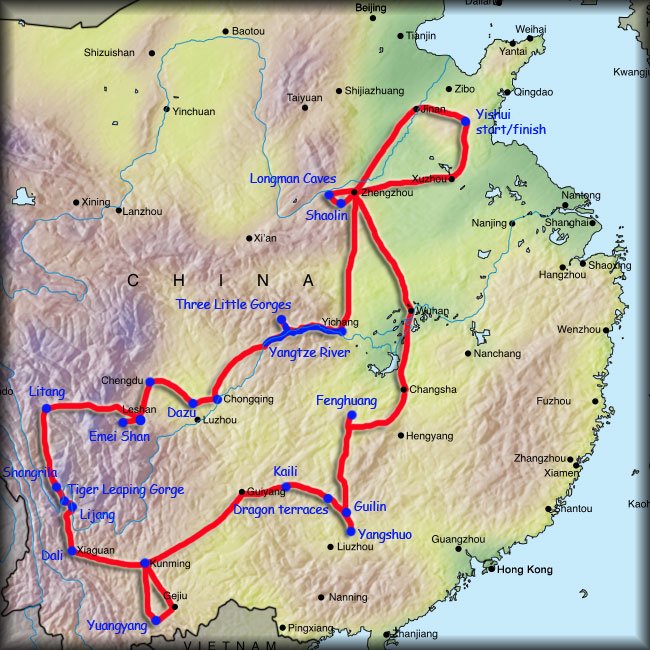

Hubei – Chongqing
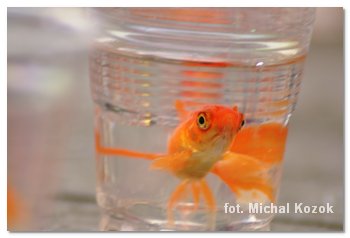 We planned to start our China's tour from the Yangtze River cruise. We arrived at Yichang, but the news was scary – there was no tourist boats between November and March. We quickly jump into variant B and we bought tickets for a regular passenger ferry. It is important not to take the express boat, because that one goes fast and there is no deck, so your views would be very limited. On the slow ferry, you can go out on deck. But unlike on the tourist ships, here is a risk to pass the most interesting attractions by night, so you should find out where and what time you are reaching the certain destinations. On the first day we took a cruise to Wushan only, where we arrived in the evening. There was no important which class we took, as almost all the time we stayed outside.
We planned to start our China's tour from the Yangtze River cruise. We arrived at Yichang, but the news was scary – there was no tourist boats between November and March. We quickly jump into variant B and we bought tickets for a regular passenger ferry. It is important not to take the express boat, because that one goes fast and there is no deck, so your views would be very limited. On the slow ferry, you can go out on deck. But unlike on the tourist ships, here is a risk to pass the most interesting attractions by night, so you should find out where and what time you are reaching the certain destinations. On the first day we took a cruise to Wushan only, where we arrived in the evening. There was no important which class we took, as almost all the time we stayed outside.
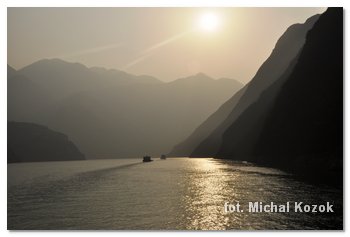 Slow boat is departing Yichang at 9 am. First there is an hour bus ride to the harbour which is already behind the Three Gorge Dam (the largest in the world, but we couldn't see it). There we were boarding a boat and after visiting the reception we went on the front deck, instead to the cabin. Around 11 am we reached the first attraction, Xiling Gorge (N 30°53.260' E 110°52.360') - the rock walls were so close that they didn't disappear into the fog. Wonderful views stayed for an hour, then the banks spread away from each other (and it was a right time to use the cabin for a short nap). For the next dose of emotions we had to wait until 4 pm. Just behind Badong town (N 31°02.580' E 110°19.490') we went into the second gorge - called Wu. Here again, the river was narrow and cliffs high. This gorge was quite long, all the way until Wushan town, where we arrived at 6 pm, just after dusk (if we continued sailing, we would pass another gorge at night). I think the regular ferries aren't so bad compared to the tourist one, which true, they stopped at the temples, but after reading so many reviews, those temples are not interesting. Although the dam construction caused the water level raised by more than 50 meters, many villages were flooded (nearly two million people were displaced). On the way there are many concrete cities and factories, but the gorge and nature is still so beautiful, that the Yangtze cruise (the third world's longest) is certainly worth.
Slow boat is departing Yichang at 9 am. First there is an hour bus ride to the harbour which is already behind the Three Gorge Dam (the largest in the world, but we couldn't see it). There we were boarding a boat and after visiting the reception we went on the front deck, instead to the cabin. Around 11 am we reached the first attraction, Xiling Gorge (N 30°53.260' E 110°52.360') - the rock walls were so close that they didn't disappear into the fog. Wonderful views stayed for an hour, then the banks spread away from each other (and it was a right time to use the cabin for a short nap). For the next dose of emotions we had to wait until 4 pm. Just behind Badong town (N 31°02.580' E 110°19.490') we went into the second gorge - called Wu. Here again, the river was narrow and cliffs high. This gorge was quite long, all the way until Wushan town, where we arrived at 6 pm, just after dusk (if we continued sailing, we would pass another gorge at night). I think the regular ferries aren't so bad compared to the tourist one, which true, they stopped at the temples, but after reading so many reviews, those temples are not interesting. Although the dam construction caused the water level raised by more than 50 meters, many villages were flooded (nearly two million people were displaced). On the way there are many concrete cities and factories, but the gorge and nature is still so beautiful, that the Yangtze cruise (the third world's longest) is certainly worth.
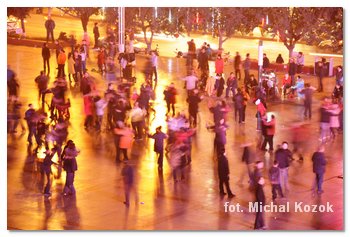 Wushan is located on the steep slope, we enjoyed the atmosphere, it was good to stay there overnight. Although there are concrete blocks and many people might not like it, especially during the daylight. The town lies at the heart of the tourist trail, but a few visitors stop here for longer. People living there were nicer than average, we were walking for hours making new relationships, or simply observing a typical Chinese street life. In Wushan is worth to do an extra trip to Three Little Gorges on the Daning River. We contacted the municipal tourism department (ph 023 57652333, 150 Y/ person). We departed the main harbor at noon. During the two-hour cruise up the river we passed three narrow gorges, with vertical cliffs, colorful rocks, greenish water. The boat was glazed, but still the best views were from the outside deck. Then we boarded a little wooden boat (up to 30 people) and we sailed for an additional half an hour to
Wushan is located on the steep slope, we enjoyed the atmosphere, it was good to stay there overnight. Although there are concrete blocks and many people might not like it, especially during the daylight. The town lies at the heart of the tourist trail, but a few visitors stop here for longer. People living there were nicer than average, we were walking for hours making new relationships, or simply observing a typical Chinese street life. In Wushan is worth to do an extra trip to Three Little Gorges on the Daning River. We contacted the municipal tourism department (ph 023 57652333, 150 Y/ person). We departed the main harbor at noon. During the two-hour cruise up the river we passed three narrow gorges, with vertical cliffs, colorful rocks, greenish water. The boat was glazed, but still the best views were from the outside deck. Then we boarded a little wooden boat (up to 30 people) and we sailed for an additional half an hour to 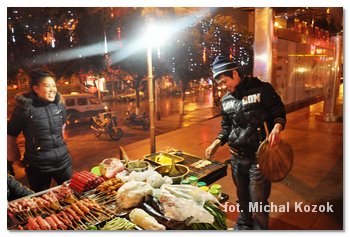 another river - this gorge is sometimes 20 meters wide. As often happened in a winter, and over the Yangtze River specially, the fog covered the good views. We don't have good pictures, but unforgettable views are in our memories.
another river - this gorge is sometimes 20 meters wide. As often happened in a winter, and over the Yangtze River specially, the fog covered the good views. We don't have good pictures, but unforgettable views are in our memories.
The next day we flow to Wanzhou by express boat, because only that way allow you to see the III Gorge during the day (twice cheaper slow boats are departing Wushan in a western direction only in the evening). We reached the Qutang Gorge after 40 minutes sailing (N 31°01.160' E 109°36.300'). This is the narrowest (up to 100m) and the shortest of the Yangtze River gorge, often regarded as the prettiest one.
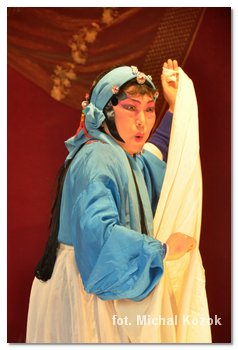 Entering the Chongqing City I felt like I came from the small village – bright neon signs, fancy decorations, crowded streets, buildings and shops illuminations - the city made an impression on us. Despite the modernity, you can walk in the old town full of wooden houses, narrow winding streets, vendors, artistic performances, etc. In the downtown there are virtually no cyclists - it is very unique for China. A city is also famous for "hotpot", a traditional spicy dish. In this friendly city our couchsurfing hosts greatly welcomed us, and we had a lot of fun and interesting discussion about travelling dreams, and about Chinese realities. With the nice relaxing foot massage (100 minutes for 68 Y) we said goodbye to Chongqing and went back on the trail.
Entering the Chongqing City I felt like I came from the small village – bright neon signs, fancy decorations, crowded streets, buildings and shops illuminations - the city made an impression on us. Despite the modernity, you can walk in the old town full of wooden houses, narrow winding streets, vendors, artistic performances, etc. In the downtown there are virtually no cyclists - it is very unique for China. A city is also famous for "hotpot", a traditional spicy dish. In this friendly city our couchsurfing hosts greatly welcomed us, and we had a lot of fun and interesting discussion about travelling dreams, and about Chinese realities. With the nice relaxing foot massage (100 minutes for 68 Y) we said goodbye to Chongqing and went back on the trail.
We arrived to Dazu at 3 pm, but we managed to see a nearby attraction, in addition, almost without the crowd. In Baoding Shan there are thousands carved rock sculptures. The variety of shapes, colors, faces, actions, size (up to 8 meters high, or more than 30 meters in length). It have a lot to admire. Most sculptures come from twelfth/thirteenth century, they are located in a rock 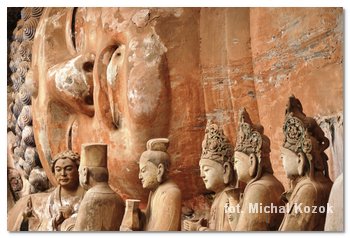 niche, but there are also some caves. The most famous sculpture is Golden God with his 1007 hands. Nearby is the Shengshousi Temple – it's still living complex where monks stay. I also recommend to see this place, but unfortunately it requires a separate ticket. We were there after 5 pm, so no one checked the tickets. Admission fees depend on the objects - Shengshousi Temple 20 Y; Bei Shan (located 10 km away, near the Dazu city center) 70 Y; sculptures in Baoding Shan 90 Y. You can also combine those all three attractions and pay 130 Y. We succeeded in obtaining 50% discount on teacher working for the People's Republic of China. However, officially only the Chinese students get discounts.
niche, but there are also some caves. The most famous sculpture is Golden God with his 1007 hands. Nearby is the Shengshousi Temple – it's still living complex where monks stay. I also recommend to see this place, but unfortunately it requires a separate ticket. We were there after 5 pm, so no one checked the tickets. Admission fees depend on the objects - Shengshousi Temple 20 Y; Bei Shan (located 10 km away, near the Dazu city center) 70 Y; sculptures in Baoding Shan 90 Y. You can also combine those all three attractions and pay 130 Y. We succeeded in obtaining 50% discount on teacher working for the People's Republic of China. However, officially only the Chinese students get discounts.

Sichuan
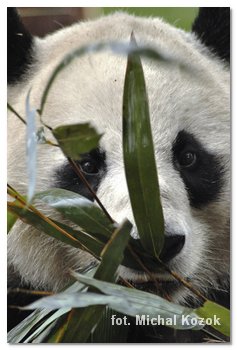 We didn't like Chengdu city, too much noise and pollution. For us the only Wenshu Monastery touristic area was ok. We didn't like the neighborhood of Wu Hou Temple, where people focused at evening along the Jin Li street, a newly developed district in the old Chinese style - artificial atmosphere.
We didn't like Chengdu city, too much noise and pollution. For us the only Wenshu Monastery touristic area was ok. We didn't like the neighborhood of Wu Hou Temple, where people focused at evening along the Jin Li street, a newly developed district in the old Chinese style - artificial atmosphere.
The Great Panda Breeding Center - price proposed by Sim's Cozy Guesthouse is 80 Y per person (from 8 to 11:30 am), and that include admission fee (58 Y). I had mixed feelings whether should I go to see these delightful creatures, or I shouldn't? I do not go to the zoo's, because I feel sorry for those tortured animals, and 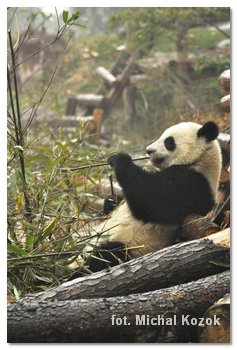 here the center was given leaflets of good rehabilitation program. In reality I have seen tiny cages and small grass runs, not big enough. For sure the center guarantees the protection and reproduction of the pandas, but these conditions could be closer to the nature one. The worst, however, is that the new panda generation won't be never release, but kept for their entire life in the cages (here or sold to other zoo's). Tourists usually are watching pandas during the morning feeding between 9-10 am. In summer babies usually sit in air-conditioned rooms, because outside is too hot. Winter is a better time, pandas are more active. They are very delightful, especially when are eating bamboos with lazy pose, looked like they just need a beer and football game in TV to be in total paradise. In addition to the main attractions (great panda), we can also see a smaller red panda, similar to the fox. Those were much more active and it was harder to take a picture. Frightening is a fact, that for killing great panda in the wild there is a death penalty in China.
here the center was given leaflets of good rehabilitation program. In reality I have seen tiny cages and small grass runs, not big enough. For sure the center guarantees the protection and reproduction of the pandas, but these conditions could be closer to the nature one. The worst, however, is that the new panda generation won't be never release, but kept for their entire life in the cages (here or sold to other zoo's). Tourists usually are watching pandas during the morning feeding between 9-10 am. In summer babies usually sit in air-conditioned rooms, because outside is too hot. Winter is a better time, pandas are more active. They are very delightful, especially when are eating bamboos with lazy pose, looked like they just need a beer and football game in TV to be in total paradise. In addition to the main attractions (great panda), we can also see a smaller red panda, similar to the fox. Those were much more active and it was harder to take a picture. Frightening is a fact, that for killing great panda in the wild there is a death penalty in China.
 In Leshan we went to see the Grand Buddha statue. And it is true that this giant is impressive. Carved sitting Buddha statue into the rock is 71 meters height. At his foot we could play volleyball match. This VIII century monument is considered to be the largest sitting Buddha statue in the world. After the entry (discounts for international student card ISIC) we climbed the stairs to the top of the statue head. We could look down and see comparative scale in form of people coming down the steep stairs on the cliff. From the ground level we could again admire the Great Buddha, this time standing next to his toes.
In Leshan we went to see the Grand Buddha statue. And it is true that this giant is impressive. Carved sitting Buddha statue into the rock is 71 meters height. At his foot we could play volleyball match. This VIII century monument is considered to be the largest sitting Buddha statue in the world. After the entry (discounts for international student card ISIC) we climbed the stairs to the top of the statue head. We could look down and see comparative scale in form of people coming down the steep stairs on the cliff. From the ground level we could again admire the Great Buddha, this time standing next to his toes.
Emei Shan is a sacred Buddhist mountain for pilgrims. On the trail to the top of the mountain were built many monasteries, where silence and tranquility monks spent their lives in praying. Today, a little remains from mysticism, and the mountain has become a tourist mecca, almost not related to any spirituality. Emei Shan is a business located in a nice place. To get to the top of this three-thousand meters high peak you do not have to walk at all - the Chinese designed lifts for the lazy tourists. First they take you by bus, then by cable car. Of course, this investment must be paid back, so the park entry ticket costs quite high as for Chinese conditions - 2-day ticket normal/student 150/80 Y (15 €/8 €). Now from Baoguo (altitude about 500m) bus to the Leidongpong parking lot (2430m) costs 40 Y in each direction. Trip by cable car is additional 65/45 Y (ascent/descent). Another word is a party for richer men.
 Of course with a little effort you are able to have an interesting trekking, and on the occasion save some money. We decided to travel by bus from Baoguo to Wuxiangang bus station (20 Y for 15 minutes ride). I started trekking a little late. I set off at noon in Wuxiangang (650m) and after 1.5 hours I reached the Wannian Temple (1020m, 10 Y admission fee), sightseeing on the way interesting Qingyin Pavilion (710m). Never before in my life I have seen so many stairs at a time - tens of kilometers the same factory stone steps (literally identical), next to them there was concrete handrail. The Elephant Bathing Pool Monastery (2070m) I reached at 5 pm. I took a dormitory and at 6 pm I went for a meal for all monastery pilgrims. There were no monks in the temple office, I have the impression that the whole mountain tourism is already owned by the state. At night I understood why only I have such a big backpack – my sleeping bag wasn't necessary, as electric blankets are installed in the beds.
Of course with a little effort you are able to have an interesting trekking, and on the occasion save some money. We decided to travel by bus from Baoguo to Wuxiangang bus station (20 Y for 15 minutes ride). I started trekking a little late. I set off at noon in Wuxiangang (650m) and after 1.5 hours I reached the Wannian Temple (1020m, 10 Y admission fee), sightseeing on the way interesting Qingyin Pavilion (710m). Never before in my life I have seen so many stairs at a time - tens of kilometers the same factory stone steps (literally identical), next to them there was concrete handrail. The Elephant Bathing Pool Monastery (2070m) I reached at 5 pm. I took a dormitory and at 6 pm I went for a meal for all monastery pilgrims. There were no monks in the temple office, I have the impression that the whole mountain tourism is already owned by the state. At night I understood why only I have such a big backpack – my sleeping bag wasn't necessary, as electric blankets are installed in the beds.
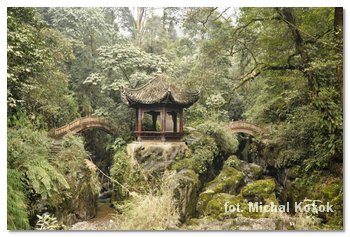 In the middle of the night, one older monk sleeping in the same dorm, started mumble the mantras. But about 3 am he decided for a real solo recital and began singing loudly, ringing the bells and playing the drum. It was the best solo concert which I have heard in the recent years. At 6 am I started hiking again. It was complete darkness and silence, first time there was no fog. It was the finest moment of climbing. But at the first few steps I understood why some vendors offered us an iron crampons. The stairs were icy that I began to doubt whether I can make it (slip down could be a painful experience). However, handrail saved my honor – I was able to lean on when necessary. After two hours trekking I've seen the first people, as I hit the parking lot in Leidongpong, 2430m. Soon there were thousands of people, it was impossible to avoid crowd. However, this 15-minute walk to the cable car station
In the middle of the night, one older monk sleeping in the same dorm, started mumble the mantras. But about 3 am he decided for a real solo recital and began singing loudly, ringing the bells and playing the drum. It was the best solo concert which I have heard in the recent years. At 6 am I started hiking again. It was complete darkness and silence, first time there was no fog. It was the finest moment of climbing. But at the first few steps I understood why some vendors offered us an iron crampons. The stairs were icy that I began to doubt whether I can make it (slip down could be a painful experience). However, handrail saved my honor – I was able to lean on when necessary. After two hours trekking I've seen the first people, as I hit the parking lot in Leidongpong, 2430m. Soon there were thousands of people, it was impossible to avoid crowd. However, this 15-minute walk to the cable car station 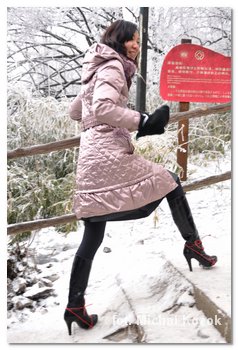 (2540m) was a maximum of Chinese capabilities – noisy screaming, hiking with the loudly music, irritating and provoking the monkeys etc. My favorite photographic subject was a woman on high heels with crampons climbing they icy stairs. After reaching the cable car station I was continuing my trekking, but there was a silence, suddenly all people have gone, only a few Chinese have decided to climb the mountain on foot, not by the cable car. And it was worth it, because I managed to go above clouds level. From the top of the Golden Summit (3077m) was a nice view, and most interestingly was presenting Wanfo Temple, standing on the neighboring hill, disappearing from time to time among the mist. At 11:15 am I started to run down, because I still wanted to catch the same day bus (as dense fog blocked any views below the summit). At 3 pm I reached Magic Peak Monastery. Since then I walked even quicker, but sometimes through the mist I could see what the beautiful views I was missing (especially between the monastery and the Tree Terrace - an error of the map - should be 1020 meters, not 1120m). Then we went to the park created for the monkeys, called Joking Monkey Zone - beware, monkeys are aggressive. They can jump on your head, take you a book, backpack, etc. Stick might be useful. At the bus station in Wuxiangang I have been just five minutes before the last bus departure (6 pm).
(2540m) was a maximum of Chinese capabilities – noisy screaming, hiking with the loudly music, irritating and provoking the monkeys etc. My favorite photographic subject was a woman on high heels with crampons climbing they icy stairs. After reaching the cable car station I was continuing my trekking, but there was a silence, suddenly all people have gone, only a few Chinese have decided to climb the mountain on foot, not by the cable car. And it was worth it, because I managed to go above clouds level. From the top of the Golden Summit (3077m) was a nice view, and most interestingly was presenting Wanfo Temple, standing on the neighboring hill, disappearing from time to time among the mist. At 11:15 am I started to run down, because I still wanted to catch the same day bus (as dense fog blocked any views below the summit). At 3 pm I reached Magic Peak Monastery. Since then I walked even quicker, but sometimes through the mist I could see what the beautiful views I was missing (especially between the monastery and the Tree Terrace - an error of the map - should be 1020 meters, not 1120m). Then we went to the park created for the monkeys, called Joking Monkey Zone - beware, monkeys are aggressive. They can jump on your head, take you a book, backpack, etc. Stick might be useful. At the bus station in Wuxiangang I have been just five minutes before the last bus departure (6 pm).
If someone does not have much time but likes walking in the mountains, I would recommend to consider the following variant: from Baoguo take a bus to the Wanian parking lot. Hence, you can climb to the temple of the same name (apparently one hour walk) or take a cable car there. Now you can march the route in its most beautiful part, to Magic Peak Monastery, passing along the way Qingyin Pavilion, Joking Monkey Zone and Hongchun Terraces. Then continue towards Elephant Bathing Pool Monastery.  Here you can spend a night and in the morning continue to the summit. After relaxing at the top go down to the Leidongpong parking lot and get down by bus. Alternatively, from the Wannian Temple you can go shorter, but less attractive route via Chu Temple. I did too much climbing and descending all the way just in one and a half day. But I had only the information about the distance, not hiking time, so it was hard to plan the optimal variant. After this trekking my leg mussels hurt for a few days, as after the marathon race. No sleeping bag was needed, and food & water was for relatively good price along the way.
Here you can spend a night and in the morning continue to the summit. After relaxing at the top go down to the Leidongpong parking lot and get down by bus. Alternatively, from the Wannian Temple you can go shorter, but less attractive route via Chu Temple. I did too much climbing and descending all the way just in one and a half day. But I had only the information about the distance, not hiking time, so it was hard to plan the optimal variant. After this trekking my leg mussels hurt for a few days, as after the marathon race. No sleeping bag was needed, and food & water was for relatively good price along the way.
Here are the distances and times between the certain points. Parts from the cable car station to the Golden Summit, and from the Magic Peak Monastery to the Qingyin Pavilion I walked very quickly, the rest at normal pace. In total I marched for 14 hours (brakes not included) - the first day from 12 to 5:30 pm, the next one from 6 am to 6 pm, 56 km on 100 million stairs:)
| point 1 |
point 1 altitude |
point 2 |
distances and times between points 1 and 2 |
| Wuxiangang |
650 m |
Qingyin Pavilion |
30 min |
2 km |
| Qingyin Pavilion |
710 m |
Wannian Monastery |
40 min |
2 km |
| Wannian Monastery |
1020 m |
Xixin Temple |
1 h |
13 km |
| Xixin Temple |
1460 m |
Chu Temple |
1 h |
| Chu Temple |
1740 m |
Huayan Peak |
25 min |
| Huayan Peak |
1900 m |
trails junction in Jiuling |
15 min |
| trails junction in Jiuling |
1820 m |
Elephant Bathing Pool |
50 min |
2 km |
| Elephant Bathing Pool |
2070 m |
Leidongping parking lot |
2 h |
5.5 km |
| Leidongping parking lot |
2430 m |
cable car station |
15 min |
| cable car station |
2540 m |
Golden Summit 3077 m |
50 min |
3.5 km |
| trails junction in Jiuling |
1820 m |
Yuxian Temple |
15 min |
5 km |
| Yuxian Temple |
1730 m |
Magic Peak Monastery |
1 h (up-down) |
| Magic Peak Monastery |
1750 m |
Hongchun Tree Terrace |
1 h 40 min |
8 km |
| Hongchun Tree Terrace |
1020 m |
Qingyin Pavilion 710 m |
50 min |
4 km |
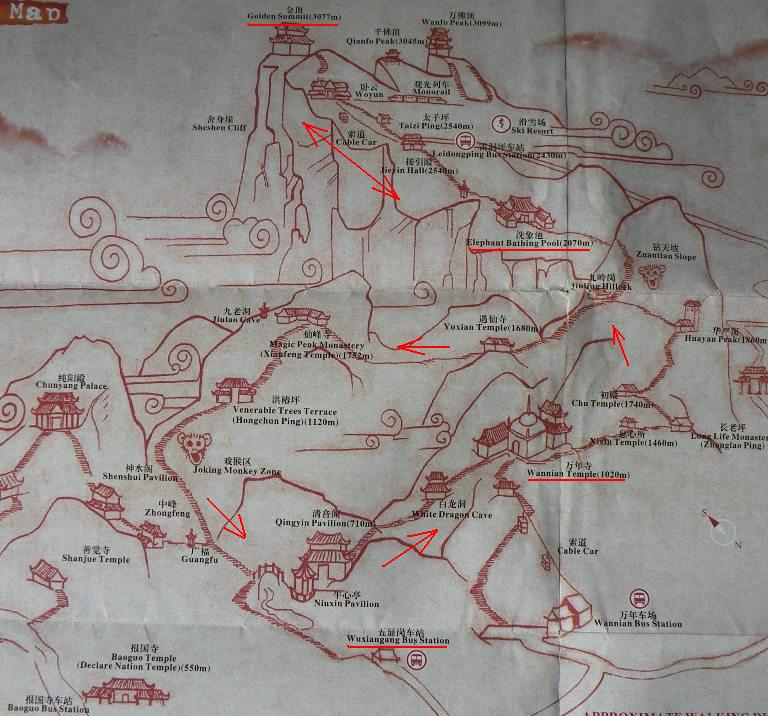
Kangding surprised us (altitude 2000m, rather than 2600m as reported in LP). We expected a typical Chinese city full of concrete houses and factories. And here was a quite nice town situated in a narrow gorge. In the middle a river flows and along it narrow streets winding. In Kangding if we climb any of the surrounding hills, we might see huge massive of Gongga Shan (7556m), which lies south from the city. In the center of the town we can see the small Anju Temple, where Buddhist monks welcome you with a smile.
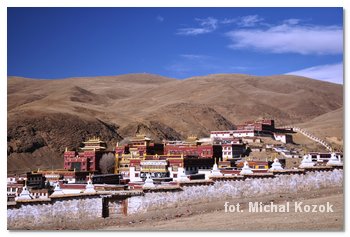
The next morning we went in Litang direction. When I have woken up by the morning sun rays, the bus was already at altitude around 4,000 meters above sea level. Landscape have been becoming more and more wild and interesting, the passing villages were very different from which we already knew from Chinese realities. When we descended from the pass into the Jalunga River ravine, we could say that we are in the Tibetan world. There were began appearing the big houses, like stone castles with leaning walls (like in cone). They weren't also in typical rectangular shapes, but irregular, with some notches, terraces on the upper floor, separate wings etc. Quite high, usually three floors one, and in the ground floor there were no windows at all. This was the most beautiful houses I have seen during this trip. Finally we reached the Yajiang village, which lies on the river cliff - many houses are still wooden, it made an impression. But we climbed higher, finally reaching the valley with Litang town.
 Litang had got negative first impression. But it was wrong measurement - a town situated at an altitude of 4,014 m has a relaxing atmosphere. The gray landscape is dominated by gray-stone Tibetan houses. The best thing there were people - peaceful, open, not used to tourists. Seeing them I was wondering if I'm in Bolivia or in China - their Indian face features, long black hair and original costumes made me a kind of extra respect and curiosity. We walked for hours - especially I recommend to see the hidden Chode Gompa Monastery in the north end of town. Maybe architecture is not the number one, but the size and atmosphere of this Buddhist Temple are impressive. The best are harmless monks, they are walking and praying. The site is totally calm, with blue sky and shining sun. Only children-monks were playing around making this place a bit alive. Unfortunately, those boys are a little scamps – throwing the firecrackers under my feet, but it should be in norm before the Chinese New Year. The boys would not let us go to the monastery without a payment, but we just waited until they get bored at the gate, or was actually easier to walk
Litang had got negative first impression. But it was wrong measurement - a town situated at an altitude of 4,014 m has a relaxing atmosphere. The gray landscape is dominated by gray-stone Tibetan houses. The best thing there were people - peaceful, open, not used to tourists. Seeing them I was wondering if I'm in Bolivia or in China - their Indian face features, long black hair and original costumes made me a kind of extra respect and curiosity. We walked for hours - especially I recommend to see the hidden Chode Gompa Monastery in the north end of town. Maybe architecture is not the number one, but the size and atmosphere of this Buddhist Temple are impressive. The best are harmless monks, they are walking and praying. The site is totally calm, with blue sky and shining sun. Only children-monks were playing around making this place a bit alive. Unfortunately, those boys are a little scamps – throwing the firecrackers under my feet, but it should be in norm before the Chinese New Year. The boys would not let us go to the monastery without a payment, but we just waited until they get bored at the gate, or was actually easier to walk  around the gate and get into through the other entrance. The boys are keen on to pose on photos. Although it was February and considerable high above sea level, there was no snow visible even on the surrounding peaks, and we could hike even in T-shirts. Probably thanks to trekking on Emei Shan, we did not have any acclimation problems.
around the gate and get into through the other entrance. The boys are keen on to pose on photos. Although it was February and considerable high above sea level, there was no snow visible even on the surrounding peaks, and we could hike even in T-shirts. Probably thanks to trekking on Emei Shan, we did not have any acclimation problems.
The next village we visited in Sichuan Province, was Xiangcheng. Located inside the deep gorge is much warmer than Litang - lies 1200 meters below and is sheltered from the wind. There are a lot more concrete government buildings, but there are still some Tibetan houses. However, they differ from those in previous villages mainly by location on the mountain slope, and that they are white. Many of them have also decorated window and door facades, making them more colorful and distinctive from its surroundings. We managed to find an accommodation in such a house - inside we got even better impression than our expectations. Ground level is used for pantry (no windows here), but going up on the next floors we found two huge halls and several smaller rooms providing enough space to accommodate few families. 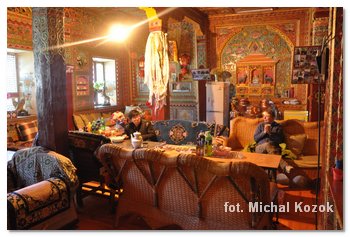 Decorations and paintings on the wooden ceilings, columns and walls were also amazing. On the last floor there is a prayer hall and outdoor terrace. Hence, you can go to the flat roof. We went for a walk to the Thangbzangdang Monastery, the Buddhist temple on the hill outside the town. I had to pay an admission fee (15 Y, unfortunately tickets are issued by government, not by monastery), but there was a good non-commercial atmosphere. While walking around the monastery the monks invited inside, we could hear mantras sung by them, watch a richly decorated interior. We were very happy that we managed to drive through incredible mountain serpentine road Kangding - Litang - Xiangcheng - Shangrila, full of amazing views.
Decorations and paintings on the wooden ceilings, columns and walls were also amazing. On the last floor there is a prayer hall and outdoor terrace. Hence, you can go to the flat roof. We went for a walk to the Thangbzangdang Monastery, the Buddhist temple on the hill outside the town. I had to pay an admission fee (15 Y, unfortunately tickets are issued by government, not by monastery), but there was a good non-commercial atmosphere. While walking around the monastery the monks invited inside, we could hear mantras sung by them, watch a richly decorated interior. We were very happy that we managed to drive through incredible mountain serpentine road Kangding - Litang - Xiangcheng - Shangrila, full of amazing views.

Yunnan
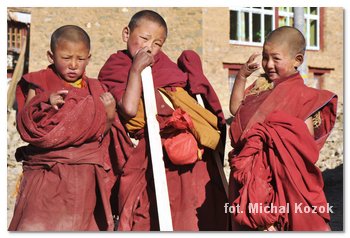 Shangrila (called sometimes Zhongdian or Deqen) is the first town in Yunnan Province on our route. The altitude 3300 meters makes only a few tourists here in the winter time. Even the centre of the old town looked deserted - most of the tourist shops were closed. However, the crisp air, old wooden houses, winding cobbled streets, etc. gave the impression of pleasant place. In addition to the interesting minorities costumes, the main attraction is the Sumtseling Monastery. To get there take bus no. 3 going north. At some point the bus will stop, and policeman will board inside and will be throwing out all "white faces". You will be directed to a big new building - there are souvenir shops and ticket office. As they told us the admission fee price,
Shangrila (called sometimes Zhongdian or Deqen) is the first town in Yunnan Province on our route. The altitude 3300 meters makes only a few tourists here in the winter time. Even the centre of the old town looked deserted - most of the tourist shops were closed. However, the crisp air, old wooden houses, winding cobbled streets, etc. gave the impression of pleasant place. In addition to the interesting minorities costumes, the main attraction is the Sumtseling Monastery. To get there take bus no. 3 going north. At some point the bus will stop, and policeman will board inside and will be throwing out all "white faces". You will be directed to a big new building - there are souvenir shops and ticket office. As they told us the admission fee price, 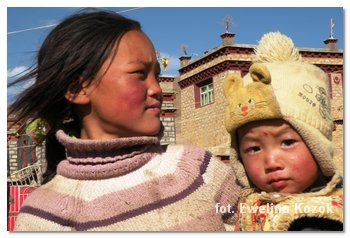 we felt unhappy - normal/student 85/55 Y. From here, you are not even able to see the monastery, so you don't know if this is worth or not. We got angry and left the house, we went to a nearby "centre of Tibetan culture", crossed the bridge over there. We started to climb the hill, located on the west side from the ticket office. We walked through the cemetery, went into the woods and walked down to the paved road and got into the crowd. Then we went to the monastery - unfortunately that was commercial one, and one crane already was constructing another “old temple”. However, if you do not plan to go to Tibet or to the Western Sichuan, it's better to see the monastery anyway. However, if you are going further on, then you definitely can miss this artificial attraction (despite its history).
we felt unhappy - normal/student 85/55 Y. From here, you are not even able to see the monastery, so you don't know if this is worth or not. We got angry and left the house, we went to a nearby "centre of Tibetan culture", crossed the bridge over there. We started to climb the hill, located on the west side from the ticket office. We walked through the cemetery, went into the woods and walked down to the paved road and got into the crowd. Then we went to the monastery - unfortunately that was commercial one, and one crane already was constructing another “old temple”. However, if you do not plan to go to Tibet or to the Western Sichuan, it's better to see the monastery anyway. However, if you are going further on, then you definitely can miss this artificial attraction (despite its history).
 Tiger Leaping Gorge is a place worth recommendation. This is a beautiful deep canyon of Yangtze River. We can see it in two ways - driving the vehicle on the bottom paved road, stopping at lookouts, or hiking the high trail (called 28-bends). We chose the trekking option - we left the Qiaotou town (1850m) before a noon. The admission fee is probably 150 Y, but there was free of charge at this time?! The path is narrow, well marked with painted red arrows, winding up for better views. The best views start after the highest point (2640 m), so you can see the vertical walls on the opposite side (Jade Dragon Snow Mountain), and some 800 meters below the winding greenish Yangtze. The best time is to be there in the afternoon, because the sun would be perfectly shining on the opposite mountains. We hiked until Halfway Guesthouse, where low accommodation and meals prices surprised us (20 Y for dormitory, 8 Y for a noodle with meat). This hostel is very popular and in the summer high season, might be overcrowded. An alternative
Tiger Leaping Gorge is a place worth recommendation. This is a beautiful deep canyon of Yangtze River. We can see it in two ways - driving the vehicle on the bottom paved road, stopping at lookouts, or hiking the high trail (called 28-bends). We chose the trekking option - we left the Qiaotou town (1850m) before a noon. The admission fee is probably 150 Y, but there was free of charge at this time?! The path is narrow, well marked with painted red arrows, winding up for better views. The best views start after the highest point (2640 m), so you can see the vertical walls on the opposite side (Jade Dragon Snow Mountain), and some 800 meters below the winding greenish Yangtze. The best time is to be there in the afternoon, because the sun would be perfectly shining on the opposite mountains. We hiked until Halfway Guesthouse, where low accommodation and meals prices surprised us (20 Y for dormitory, 8 Y for a noodle with meat). This hostel is very popular and in the summer high season, might be overcrowded. An alternative 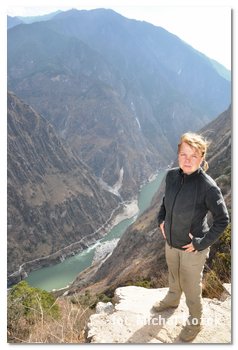 may be two other hostels located just several minutes away, but only the second one (Five Fingers) has also such interesting view from the terrace. On the entire route there is no problem to purchase relatively cheap food and bottled water.
may be two other hostels located just several minutes away, but only the second one (Five Fingers) has also such interesting view from the terrace. On the entire route there is no problem to purchase relatively cheap food and bottled water.
The next day we went to Tina's Guesthosue (junction of trekking trail and paved road), where we left our heavy backpacks and began to descent direct to the middle rapids. Descent (400m vertical) can be done in two places. The first one begins from Tina's, but aggressive lady is charging 10 Y fee for using track made by her family. But this path does not have good views, I propose to go down by the trail called Sky Ladder - from Tina's go by the paved road over the bridge, a couple houses later on the right side is a pub/guesthouse. There is also a charge of 10 Y for the using the trail with chains and ladders, but this track is much more interesting. In addition, there are installed two 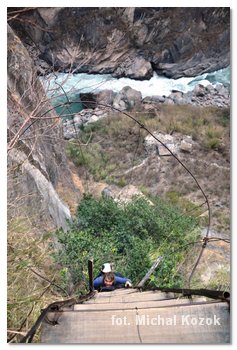 vertical steel ladders, and one of them is approximately 20 meters high (an alternative path exist around it). For people who doesn't have much contact with rock climbing, that may cause a adrenaline rise. Going back may be on the other way, the lady does not charge for people climbing up. If, however, you go the opposite way ie Tina's trail down and back up on the ladders, you will be charged twice. Cataracts are doing same impression, standing next to them I felt the power of the river. It's worth to see this attraction. In Tina's GH most tourists are renting a transport to return to the starting point. We, after having lunch, were continuing our journey further. The last picturesquely situated village is Walnut Garden (Sean's Guesthouse is located here). Thus,
vertical steel ladders, and one of them is approximately 20 meters high (an alternative path exist around it). For people who doesn't have much contact with rock climbing, that may cause a adrenaline rise. Going back may be on the other way, the lady does not charge for people climbing up. If, however, you go the opposite way ie Tina's trail down and back up on the ladders, you will be charged twice. Cataracts are doing same impression, standing next to them I felt the power of the river. It's worth to see this attraction. In Tina's GH most tourists are renting a transport to return to the starting point. We, after having lunch, were continuing our journey further. The last picturesquely situated village is Walnut Garden (Sean's Guesthouse is located here). Thus, 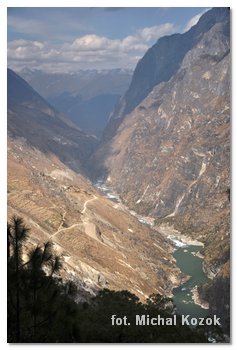 continuing the march to the old ferry is taking roughly three hours. The ferry is running the whole year, but you should be there no later then 5 pm (20 Y). However, much closer is the new ferry, but due to too high water levels it doesn't run in June, July and August. On the main road is marked sign with owner phone number. Before you start descending, you should call the owner and arrange (in Chinese) the Yangtze River crossing condition. The trail is a steep descend and takes over 30 minutes (250 meters vertical). After 3 minutes river crossing (negotiated down to 20 Y per person) we started climbing up the opposite bank slope. On the top, the boat owner offered a minibus ride to Lijiang, but unfortunately his price was 500 Y. We walked to Daju town in 1.5 hour. The official bus to Lijiang is leaving at 7:30 am and 1:30 pm (25 Y).
continuing the march to the old ferry is taking roughly three hours. The ferry is running the whole year, but you should be there no later then 5 pm (20 Y). However, much closer is the new ferry, but due to too high water levels it doesn't run in June, July and August. On the main road is marked sign with owner phone number. Before you start descending, you should call the owner and arrange (in Chinese) the Yangtze River crossing condition. The trail is a steep descend and takes over 30 minutes (250 meters vertical). After 3 minutes river crossing (negotiated down to 20 Y per person) we started climbing up the opposite bank slope. On the top, the boat owner offered a minibus ride to Lijiang, but unfortunately his price was 500 Y. We walked to Daju town in 1.5 hour. The official bus to Lijiang is leaving at 7:30 am and 1:30 pm (25 Y).
Here are the distances and times of our trekking between the certain points (Ewelina's pace with heavy backpack, only to cataracts we descended with no luggage). In total we marched for 14 hours (brakes not included) - the first day from 11 am to 6 pm, the next one from 8 am to 7 pm, 33 km.
| point 1 |
point 1 altitude |
point 2 |
distances and times between points 1 and 2 |
| Qiaotou |
1850 m |
Naxi Family Guesthouse |
2 h |
4 km |
| Naxi Family Guesthouse |
- |
the highest trekking point |
1 h 40 min |
2.5 km |
| the highest trekking point |
2640 m |
Tea Horse Guesthouse |
1 h |
3 km |
| Tea Horse Guesthouse |
- |
Halfway Guesthouse |
1 h 30 min |
4 km |
| Halfway Guesthouse |
2400 m |
Tina's Guesthouse |
1 h 40 min |
5.5 km |
| Tina's Guesthouse |
2070 m |
middle rapids |
45 min |
1 km |
| middle rapids |
1690 m |
Tina's Guesthouse |
1 h |
1 km |
| Tina's Guesthouse |
2070 m |
Walnut Gardens |
30 min |
2 km |
| Walnut Gardens |
1950 m |
descend trail beginning |
40 min |
2.5 km |
| descend trail beginning |
1870 m |
new winter ferry |
40 min |
1 km |
| new winter ferry |
1610 m |
parking on the top |
50 min |
1 km |
| parking on the top |
1900 m |
Daju (1750 m) |
1 h 30 min |
6 km |
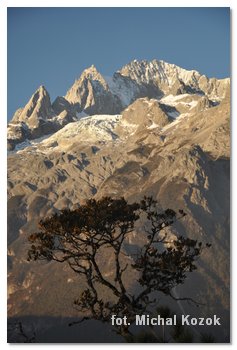 On the way from Daju to Lijiang I strongly recommend to stop at Yulong Xueshan, the base of Jade Dragon Snow Mountain (the other side of the mountain that you can see while trekking in Tiger Leaping Gorge). Unfortunately, sometimes the Lonely Planet author has done too many mistakes. This time she confused me with names – she described Yangping as the cable car to the glacier. This is wrong, because the cable car going to the altitude of 4,506 meters is not called Yangping. To get to this beautiful glacier you need to get to the tourist center called Mpression Jaku and purchase a ticket for 172 Y, which includes the bus trip to the lower station, and the ascent and descent by cable car (at the bottom you even can borrow oxygen masks!). Tourist brochures are very impressive. When finally I have realized the author mistake and quickly got to Mpression Jaku, but the cable car was already closing due to the strong wind (which apparently often happens in the afternoons). I had to admire the snow-covered rocky Jade Dragon Mountain only from the ground level, what anyway still was wonderful.
On the way from Daju to Lijiang I strongly recommend to stop at Yulong Xueshan, the base of Jade Dragon Snow Mountain (the other side of the mountain that you can see while trekking in Tiger Leaping Gorge). Unfortunately, sometimes the Lonely Planet author has done too many mistakes. This time she confused me with names – she described Yangping as the cable car to the glacier. This is wrong, because the cable car going to the altitude of 4,506 meters is not called Yangping. To get to this beautiful glacier you need to get to the tourist center called Mpression Jaku and purchase a ticket for 172 Y, which includes the bus trip to the lower station, and the ascent and descent by cable car (at the bottom you even can borrow oxygen masks!). Tourist brochures are very impressive. When finally I have realized the author mistake and quickly got to Mpression Jaku, but the cable car was already closing due to the strong wind (which apparently often happens in the afternoons). I had to admire the snow-covered rocky Jade Dragon Mountain only from the ground level, what anyway still was wonderful.
A day earlier we were sure that we are staying under the described cable car to the glacier. It turned out that there was no hotel in Yangping, but nice staff opened for us a waiting room. We woke up in the morning when we heard the first tourists bus. I said goodbye to Ewelina as I wanted to 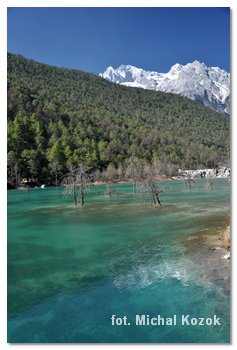 climb to the top, as the description in LP mentioned the possibility of renting horses at the top, so I was sure that some paths exists. I thought I was going for a minimum 5-hour climb. But I was surprised when I saw the final cable car station just after 30 minutes of peaceful hike. It turned out that I got just 300 meters above, to altitude of 3240 m. The cable car for this short distance costs 55 Y. Yangping turned out to be a place what I didn't look for, but anyway this is a charming place (if you ignore hundreds screaming Chinese groups). Beautiful view of the Spruce Meadow, forest and massif snow-capped Jade Dragon Mountain at the background. The entire loop at the top takes just 15 minutes walk. I recommend to go there as soon as possible, preferably at sunrise when the mountains are in orange colour – such a wonder! The biggest tourists rip-off is offering to use electric car – 10 Y for each ride. The rides are so short, so there is no reason to pay for it. After sightseeing we went down to the main road and continued our trekking along the electric cars route - after a few minutes walking we arrived to the next attraction – the turquoise lake and the beautiful cascade waterfall. People are taking payable pictures sitting on the yak in the middle of this waterfall, or keeping an eagle on own arm. In the background beautiful mountains. Everything would be ok, if not the fact, that we discovered that
climb to the top, as the description in LP mentioned the possibility of renting horses at the top, so I was sure that some paths exists. I thought I was going for a minimum 5-hour climb. But I was surprised when I saw the final cable car station just after 30 minutes of peaceful hike. It turned out that I got just 300 meters above, to altitude of 3240 m. The cable car for this short distance costs 55 Y. Yangping turned out to be a place what I didn't look for, but anyway this is a charming place (if you ignore hundreds screaming Chinese groups). Beautiful view of the Spruce Meadow, forest and massif snow-capped Jade Dragon Mountain at the background. The entire loop at the top takes just 15 minutes walk. I recommend to go there as soon as possible, preferably at sunrise when the mountains are in orange colour – such a wonder! The biggest tourists rip-off is offering to use electric car – 10 Y for each ride. The rides are so short, so there is no reason to pay for it. After sightseeing we went down to the main road and continued our trekking along the electric cars route - after a few minutes walking we arrived to the next attraction – the turquoise lake and the beautiful cascade waterfall. People are taking payable pictures sitting on the yak in the middle of this waterfall, or keeping an eagle on own arm. In the background beautiful mountains. Everything would be ok, if not the fact, that we discovered that 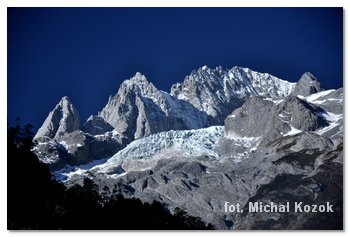 this waterfall cascade is an artificial, poured concrete. It's really annoy me that Chinese are trying to make nature more beautiful than it is in natural form. I do not like such interference in the nature. Later we got to Baishui (White Water). There are another turquoise lake (I'm afraid that the water color can be done chemically, without considering the environment) with artificial stone waterfalls, bridges and other pseudo attractions. If someone has not enough, the further you can get to Yak Meadow, with another cable car to another lookout, this time with a mountain reflecting in the lake. Generally Yulong Xueshan is a beautiful place, even with this commercialization.
this waterfall cascade is an artificial, poured concrete. It's really annoy me that Chinese are trying to make nature more beautiful than it is in natural form. I do not like such interference in the nature. Later we got to Baishui (White Water). There are another turquoise lake (I'm afraid that the water color can be done chemically, without considering the environment) with artificial stone waterfalls, bridges and other pseudo attractions. If someone has not enough, the further you can get to Yak Meadow, with another cable car to another lookout, this time with a mountain reflecting in the lake. Generally Yulong Xueshan is a beautiful place, even with this commercialization.
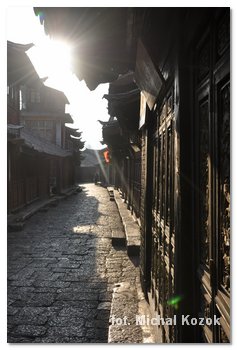 Lijiang is a town with original architecture. Miraculously the old houses weren't demolished, what in China is an unique thing - most of the old settlements are razed and a new concrete suburbs are building. Old Lijiang town is on the UNESCO heritage list. You can walk in the old town for hours, admiring the finishing of roofs, wooden ceiling, charming cafes, illuminated canals winding along cobbled streets and traversing them footbridges. Although the buildings are authentic, there is a lack of ordinary residents atmosphere. Virtually all the houses are for tourists - souvenir shops, clubs, restaurants or hotels. There is huge tourists crowd, mainly Chinese one, but fortunately no cars allowed. Well, I have respect for shop sellers and restaurants owners – they don't hassle at all. We could look the souvenirs, try to fit the clothes, read a menu, etc in peace, without the pressure. The best time to stroll around is early in the morning – the streets are empty. Sometimes we have a chance to see the Naxi minorities in their traditional colorful costumes. It is interesting that this tribe is the only one in the world who still are using hieroglyphic writing. As norm for 55 ethnic minorities living in China, they do not speak Chinese in everyday use, but using their own dialect.
Lijiang is a town with original architecture. Miraculously the old houses weren't demolished, what in China is an unique thing - most of the old settlements are razed and a new concrete suburbs are building. Old Lijiang town is on the UNESCO heritage list. You can walk in the old town for hours, admiring the finishing of roofs, wooden ceiling, charming cafes, illuminated canals winding along cobbled streets and traversing them footbridges. Although the buildings are authentic, there is a lack of ordinary residents atmosphere. Virtually all the houses are for tourists - souvenir shops, clubs, restaurants or hotels. There is huge tourists crowd, mainly Chinese one, but fortunately no cars allowed. Well, I have respect for shop sellers and restaurants owners – they don't hassle at all. We could look the souvenirs, try to fit the clothes, read a menu, etc in peace, without the pressure. The best time to stroll around is early in the morning – the streets are empty. Sometimes we have a chance to see the Naxi minorities in their traditional colorful costumes. It is interesting that this tribe is the only one in the world who still are using hieroglyphic writing. As norm for 55 ethnic minorities living in China, they do not speak Chinese in everyday use, but using their own dialect.
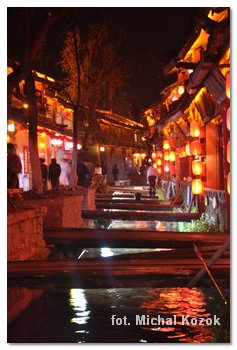 We welcomed here a Chinese New Year. In 2010 it happened at night between 13 and 14 February. The year which just passed away was named “cow”, and “tiger” began. Actually, on the street nothing extraordinary had happened, although pubs were full, but no different than in normal Saturday. We heard fireworks and firecrackers for the last two weeks - on New Year's Eve a bit more intensive, but nothing special. You cannot compare it with European celebrating. Most Chinese people are spending a New Year with their family, preparing a meal together (usually dumplings) at home, they don't go outside. In addition, Spring Festival takes over two weeks - the day of the New Year is just one of 15 days to celebrate. We waited all the evening for a party, but since 10 pm streets and clubs slowly began to be empty. There was only a little celebration at midnight. Except noisy fireworks there were vendors preparing the offerings in small altars in shop's front door. There were fruits and other foods, burning candles, scent sticks, and owners with their families were praying.
We welcomed here a Chinese New Year. In 2010 it happened at night between 13 and 14 February. The year which just passed away was named “cow”, and “tiger” began. Actually, on the street nothing extraordinary had happened, although pubs were full, but no different than in normal Saturday. We heard fireworks and firecrackers for the last two weeks - on New Year's Eve a bit more intensive, but nothing special. You cannot compare it with European celebrating. Most Chinese people are spending a New Year with their family, preparing a meal together (usually dumplings) at home, they don't go outside. In addition, Spring Festival takes over two weeks - the day of the New Year is just one of 15 days to celebrate. We waited all the evening for a party, but since 10 pm streets and clubs slowly began to be empty. There was only a little celebration at midnight. Except noisy fireworks there were vendors preparing the offerings in small altars in shop's front door. There were fruits and other foods, burning candles, scent sticks, and owners with their families were praying.
Outside Lijiang old town the popular attraction is Dragon Pool Park, located some 10 minutes walking from the center. Admission fee is expensive - 80 Y. However, if you walk around the first ticket office gate and continue march to the north along the western park fence, you pass the second gate, until you reach the third gate, next to the bridge on your right. You still go farther north, to the nearby second 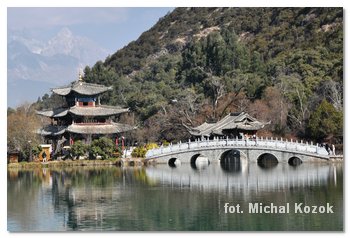 bridge - there is free entry without any gate (about 10 minutes walk from the first ticket office). Climbing the nearby Elephant Hill wasn't the best option, we didn't like the city view. The park itself is very artificial, but there is one interesting photo spot - view of lake, pagodas, bridge with arches and Jade Dragon Mountains in the background (best light in the morning). Another attraction in central Lijiang is park on hill built specifically for tourists (known as Wanggu Lou). There is a newly-built pagoda (where you can buy souvenirs) and some trees. Park disappointed us, it's nothing special, although entry fee is just 15 Y. We have a similar old city view from Long Man Inn pub (just two levels lower than the entrance to the Park), where you can drink a beer, yak milk or green tea (10-12 Y) and have a look at the old town roofs.
bridge - there is free entry without any gate (about 10 minutes walk from the first ticket office). Climbing the nearby Elephant Hill wasn't the best option, we didn't like the city view. The park itself is very artificial, but there is one interesting photo spot - view of lake, pagodas, bridge with arches and Jade Dragon Mountains in the background (best light in the morning). Another attraction in central Lijiang is park on hill built specifically for tourists (known as Wanggu Lou). There is a newly-built pagoda (where you can buy souvenirs) and some trees. Park disappointed us, it's nothing special, although entry fee is just 15 Y. We have a similar old city view from Long Man Inn pub (just two levels lower than the entrance to the Park), where you can drink a beer, yak milk or green tea (10-12 Y) and have a look at the old town roofs.
 People compare Dali to Lijiang, but for me there are no two opinions - the old town of Dali is not as interesting. The streets are wide and straight (city divided into blocks), with a slight slope, almost flat. Unfortunately local people were not particularly open to tourists. Dali is situated on Erhai Hu Lake (about 5 km from the old town), but small regular boats were replaced by large and expensive tourists cruise ferries. To see a panorama of Dali and the lake you can catch a chair-lift or climb the nearby Zhonghe mountain. Of course almost all tourist goes to the Three Pagoda Temple. Well, quite expensive entry, normal/student 121/62 Y. We walked around the complex, from where you can also see these temples. Located behind a temple another complex of Chongsheng is a complete reconstruction. Anyway, same as the main 70-meter high pagoda, which looks like a new one, the site has no character.
People compare Dali to Lijiang, but for me there are no two opinions - the old town of Dali is not as interesting. The streets are wide and straight (city divided into blocks), with a slight slope, almost flat. Unfortunately local people were not particularly open to tourists. Dali is situated on Erhai Hu Lake (about 5 km from the old town), but small regular boats were replaced by large and expensive tourists cruise ferries. To see a panorama of Dali and the lake you can catch a chair-lift or climb the nearby Zhonghe mountain. Of course almost all tourist goes to the Three Pagoda Temple. Well, quite expensive entry, normal/student 121/62 Y. We walked around the complex, from where you can also see these temples. Located behind a temple another complex of Chongsheng is a complete reconstruction. Anyway, same as the main 70-meter high pagoda, which looks like a new one, the site has no character.
Kunming, as for Chinese cities, is quite civilized, clean and organized. But we were just passing by, leaving our big backpacks in the hostel storage and quickly going in the southern direction. Our goal was Yuanyang rice terraces. I liked the pictures, when the terraces were filled with water and reflected the sun light 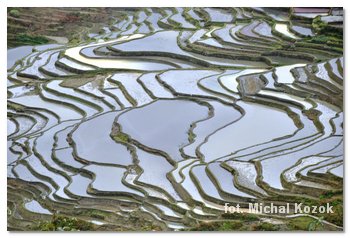 - that is, during the period from November to April. Rice planting period (May) is already not as such picturesque, but you can see people working in the field. Also interesting are the views in the period from May to August, when fields are in green and yellow colour, looks like an waving ocean when wind blows. However, after the harvest, ie from September to October, gold colour is dominating. We were in perfect time, when the terraces of different shapes were flooded with water. Unfortunately now it's a huge tourist business. In Yuanyang a transport mafia exist, offering prices for tourists at least twice higher than for the locals. So we walked to the lookouts and after two hours we reached the junction with ticket office – probably 60 Y per person (I'm not sure, as the gates were closed at night and we went in for free).
- that is, during the period from November to April. Rice planting period (May) is already not as such picturesque, but you can see people working in the field. Also interesting are the views in the period from May to August, when fields are in green and yellow colour, looks like an waving ocean when wind blows. However, after the harvest, ie from September to October, gold colour is dominating. We were in perfect time, when the terraces of different shapes were flooded with water. Unfortunately now it's a huge tourist business. In Yuanyang a transport mafia exist, offering prices for tourists at least twice higher than for the locals. So we walked to the lookouts and after two hours we reached the junction with ticket office – probably 60 Y per person (I'm not sure, as the gates were closed at night and we went in for free). 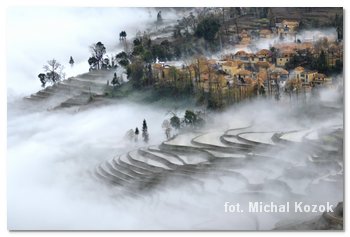 We ended up (hiking and hitchhiking) in Sheng Cun, the last village before Duoyishu. Here, it was already after 10 pm, so we were looking for accommodation - hotel offered 150 Y per night, so we found a shop where the owner gave us her own room for 50 Y.
We ended up (hiking and hitchhiking) in Sheng Cun, the last village before Duoyishu. Here, it was already after 10 pm, so we were looking for accommodation - hotel offered 150 Y per night, so we found a shop where the owner gave us her own room for 50 Y.
In the morning we woke up well before sunrise and then we went slightly uphill to Duoyishu. After 50 minutes we reached the target. Well, for sunrise (about 7:40 am in February) we arrived on time, but dense fog covered all views. After one hour waiting, when the visibility dropped down to less than 100 meters, we gave up, same like most visitors. A little sad, we were looking for a hostel to warm us up, as the terraces are built at an altitude of 2000 meters. In the lower village we found hidden Sunny Lodge, we drank a tea and waited. 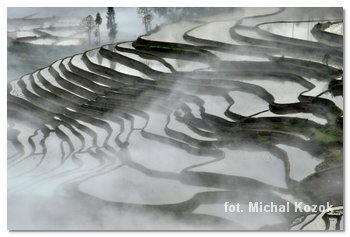 After another two hours when the fog situation hasn't improved at all, we decided to abound our plan to hike to Laohuzui terraces, where theoretically is worth to be at sunset. But the weather was so hopeless, that soon we entered the unnamed hotel (Sunny Lodge charged too much - 90 Y per person). The hotel was still under final construction, so after bargain we got a room (60 Y per room, noodle soup 5 Y). After a few hours the weather began to improve and I went on the hotel terrace. A beautiful view appeared to my eyes - hundreds of irregular rice fields lied in layers on the slope, every free landscape space was filled with those rice terraces. Water reflections confused me, where is the sky, and where is the water. I went back to the room, grabbed my camera and ran back to lookouts to take pictures. Then, a few hundred meters further the fog-cloud re-covered my views again. I went back to the hotel, a bit happy, but still something I was missing. Exactly the
After another two hours when the fog situation hasn't improved at all, we decided to abound our plan to hike to Laohuzui terraces, where theoretically is worth to be at sunset. But the weather was so hopeless, that soon we entered the unnamed hotel (Sunny Lodge charged too much - 90 Y per person). The hotel was still under final construction, so after bargain we got a room (60 Y per room, noodle soup 5 Y). After a few hours the weather began to improve and I went on the hotel terrace. A beautiful view appeared to my eyes - hundreds of irregular rice fields lied in layers on the slope, every free landscape space was filled with those rice terraces. Water reflections confused me, where is the sky, and where is the water. I went back to the room, grabbed my camera and ran back to lookouts to take pictures. Then, a few hundred meters further the fog-cloud re-covered my views again. I went back to the hotel, a bit happy, but still something I was missing. Exactly the 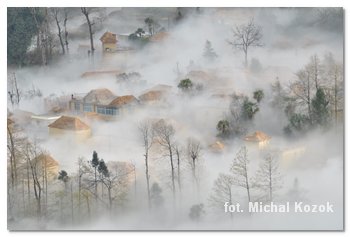 same situation repeated an hour later. Sometimes, however, worth to be stubborn, and when it cleared up for the third time, I ran out from the hotel again. Then I reached the lookout and thick like milk fog-cloud flooded the landscape once again. It was an hour before dusk, and I knew it was my last chance, so I was waiting there for a miracle. And the miracle came soon together with change of atmospheric pressure - cloud and mist began to fall, actually cracked into two parts – it was above and below us. But that was enough to see terraces again, which look almost like a human art work. Despite the very low sunlight, the sight was magnificent. From alternately lifting and falling clouds, individual trees, houses, until finally the whole terraces started to loom up. Professional photographers warmed up the atmosphere with shouts of joy, whistling, singing etc, they waited patiently here for the falling mist moment. There was no crowd, so I found a place to set up my camera. I tried to capture this beauty in many ways, experimenting with exposure,
same situation repeated an hour later. Sometimes, however, worth to be stubborn, and when it cleared up for the third time, I ran out from the hotel again. Then I reached the lookout and thick like milk fog-cloud flooded the landscape once again. It was an hour before dusk, and I knew it was my last chance, so I was waiting there for a miracle. And the miracle came soon together with change of atmospheric pressure - cloud and mist began to fall, actually cracked into two parts – it was above and below us. But that was enough to see terraces again, which look almost like a human art work. Despite the very low sunlight, the sight was magnificent. From alternately lifting and falling clouds, individual trees, houses, until finally the whole terraces started to loom up. Professional photographers warmed up the atmosphere with shouts of joy, whistling, singing etc, they waited patiently here for the falling mist moment. There was no crowd, so I found a place to set up my camera. I tried to capture this beauty in many ways, experimenting with exposure,  filters and frames. After twenty minutes the show was over. But it was a moment which was worth waiting for – the mist just added positive atmosphere to the whole spectacle. Sometimes when I watched the photographic exhibitions and were looking at some photos, it very annoyed me that some of the pictures are not natural, made in photoshop a lot far beyond the tasteless. This time I watched my photos containing the “floating village in the mist” - it looked like painting. I wouldn't believe if someone told me that it is a natural picture. We had the next day to stroll around, but this time the fog didn't give us even a minute to wonder, so we returned. We didn't like locals so much, but the Yuanyang rice terraces is a place worth of any positive recommendation (for the views, not people).
filters and frames. After twenty minutes the show was over. But it was a moment which was worth waiting for – the mist just added positive atmosphere to the whole spectacle. Sometimes when I watched the photographic exhibitions and were looking at some photos, it very annoyed me that some of the pictures are not natural, made in photoshop a lot far beyond the tasteless. This time I watched my photos containing the “floating village in the mist” - it looked like painting. I wouldn't believe if someone told me that it is a natural picture. We had the next day to stroll around, but this time the fog didn't give us even a minute to wonder, so we returned. We didn't like locals so much, but the Yuanyang rice terraces is a place worth of any positive recommendation (for the views, not people).
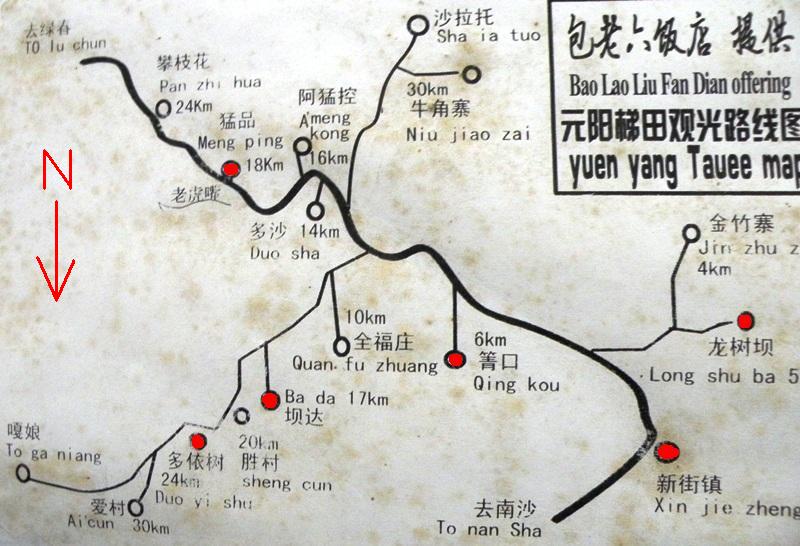

Guizhou
 We went to Kaili village for two reasons. The first one was an invitation by the CS host, the girl seemed to be really nice. That should be our "back door" for contacts with the minorities living in this area. Unfortunately, we missed her, as she forgot to give us a phone contact number on time. Our second reason was a nice photo in Lonely Planet - a traditional wooden village looked really interesting. But described picture wasn't certainly made in Kaili, only in one of the surrounding villages. If we knew it, we would go there straight away, because Kaili is a typical
We went to Kaili village for two reasons. The first one was an invitation by the CS host, the girl seemed to be really nice. That should be our "back door" for contacts with the minorities living in this area. Unfortunately, we missed her, as she forgot to give us a phone contact number on time. Our second reason was a nice photo in Lonely Planet - a traditional wooden village looked really interesting. But described picture wasn't certainly made in Kaili, only in one of the surrounding villages. If we knew it, we would go there straight away, because Kaili is a typical 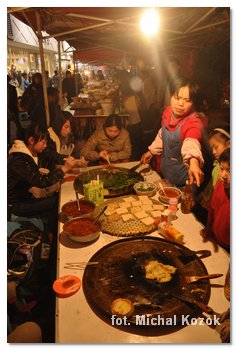 Chinese ugly concrete town. But we already checked-in in a hotel, before we discovered that our goal is not Kaili. Though the evening atmosphere was ok, street stalls serving delicacies food (we discovered potato pancakes) and even you can play ping-pong match on the street. We decided to make a day trip to nearby Langde village. This was a good choice - typical wooden village built on a slope with narrow winding cobbled streets. Such as Lijiang, but without the crowd. Actually, no tourists at all, we met only two Chinese travellers. The village is situated in a ravine among picturesque fields cultivated by locals. It was an escape from the noisy and polluted China - there was peace and quiet, I could feel the real village. Best of all, however, proved to be a contacts with the villagers - a very friendly attitude, people greeted us with smiling. Village residents represent Miao minority. Women wear embroidered headdress which show their social and marital status (although many of them had pink Chinese towel!). Hence, you can take 15 kilometers hike up stream the small river. Along the way you will be passing the next villages, hopefully inhabited by equally open people. You don't have to return the same track, as you will back to the main road Kaili - Leishan, very close to the latter location.
Chinese ugly concrete town. But we already checked-in in a hotel, before we discovered that our goal is not Kaili. Though the evening atmosphere was ok, street stalls serving delicacies food (we discovered potato pancakes) and even you can play ping-pong match on the street. We decided to make a day trip to nearby Langde village. This was a good choice - typical wooden village built on a slope with narrow winding cobbled streets. Such as Lijiang, but without the crowd. Actually, no tourists at all, we met only two Chinese travellers. The village is situated in a ravine among picturesque fields cultivated by locals. It was an escape from the noisy and polluted China - there was peace and quiet, I could feel the real village. Best of all, however, proved to be a contacts with the villagers - a very friendly attitude, people greeted us with smiling. Village residents represent Miao minority. Women wear embroidered headdress which show their social and marital status (although many of them had pink Chinese towel!). Hence, you can take 15 kilometers hike up stream the small river. Along the way you will be passing the next villages, hopefully inhabited by equally open people. You don't have to return the same track, as you will back to the main road Kaili - Leishan, very close to the latter location.

Guangxi
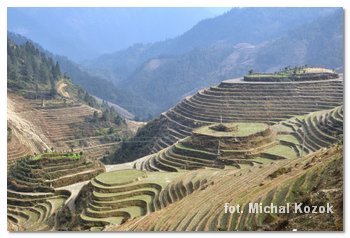 Around Longsheng there are famous Dragon's Backbone Rice Terraces (Longji Titian). I must admit that they are not as photogenic as those in Yuanyang (Yunnan province - description above), but they are still impressive. They are simply different. The downside was certainly the fact that the terraces didn't contain the water at this time of the year (February). There is not only rice cultivated, as you can see grass, canola, lettuce and other vegetables (in Yuanyang is practically only rice). This different purpose of terraces makes a little chaos in the visual effect. However, these cultivated terraces have one great advantage over an extremely picturesque Yuanyang Rice Terraces - here are walking trails. You are able to hike on the narrow stone path and wandering hundreds terraces surrounding you. We were alone with nature and those creations of the human titanic job.
Around Longsheng there are famous Dragon's Backbone Rice Terraces (Longji Titian). I must admit that they are not as photogenic as those in Yuanyang (Yunnan province - description above), but they are still impressive. They are simply different. The downside was certainly the fact that the terraces didn't contain the water at this time of the year (February). There is not only rice cultivated, as you can see grass, canola, lettuce and other vegetables (in Yuanyang is practically only rice). This different purpose of terraces makes a little chaos in the visual effect. However, these cultivated terraces have one great advantage over an extremely picturesque Yuanyang Rice Terraces - here are walking trails. You are able to hike on the narrow stone path and wandering hundreds terraces surrounding you. We were alone with nature and those creations of the human titanic job.
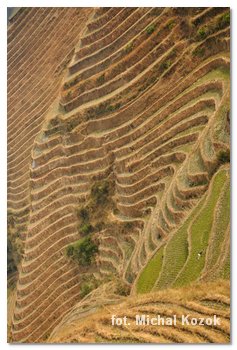 Dragon's Backbone Rice Terraces deserves its proud name – people have already begun to build it in the thirteenth century and through rest of the centuries it spread to enormous size. Currently terraces cover an area over 70 square kilometers. They are built one on each other, stretched on altitude between 400m and 1200m above sea level. Just imagine 800 meters steep slopes cut into parallel strips - it looks brilliant. We did two days trekking around (with light daypacks only).
Dragon's Backbone Rice Terraces deserves its proud name – people have already begun to build it in the thirteenth century and through rest of the centuries it spread to enormous size. Currently terraces cover an area over 70 square kilometers. They are built one on each other, stretched on altitude between 400m and 1200m above sea level. Just imagine 800 meters steep slopes cut into parallel strips - it looks brilliant. We did two days trekking around (with light daypacks only).
Day 1 - 7 hours hike, from 8 am to 6 pm, 26 km
We started in Heping town (300m), we went uphill on the path beginning next to a new bridge at the main road Longsheng - Guilin. We walked the beaten track (very little traffic), gradually gaining the altitude. To our surprise the entry ticket wasn't expensive, just 50 Y. Hence it was only two hours walking to Longji Old Zhuang village, where we had breakfast. Villages are in style similar to those near Kaili, but inhabited by other ethnic minorities, mainly by Zhuang and Yao. Virtually all the villages in the area are built from wood, quite well integrated into the landscape. Then, in the next 50 minutes we came to the Ping'An. Above this village is located lookout no. 2, called Seven Stars Accompanying The Moon, just a few minutes walk away. This is an interesting view of cone hills, cut by layers of terraces. Hence, we can traverse the slope to get to lookout no. 1, called Nine Dragons and Five Tigers. Anyway, there is more interesting to 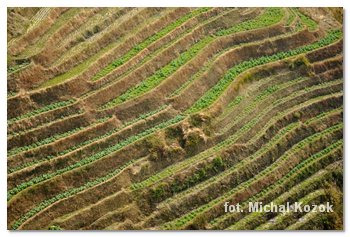 get there by the lower route through Ping'An village (45 min). From the lookout no. 1 you can admire the entire valley with picturesque terraces together with the Ping'An village. Terraces located to the east from Zhonghu village are called Ping'An, and those lying to the west are called Keng Jin. So we walked to Zhonghu village (1h 15min) – through the forest which is dividing these two large groups of terraces. Along the way we have seen an interesting old graves, which are underground, inside the terraces. Later we walked alone, in silence, from Zhonghu to Tian Tou village (1h 15 minutes). For the sunset we quickly run to lookout no. 2, called High Ladder To the Heaven, approximately 10-15 minutes walk, depending from which part of the village. View of the Keng Jin terraces was ok, and before the dusk we returned to the village to find a hotel with nice view and friendly service. There are plenty of good views, but people were a bit insistent.
get there by the lower route through Ping'An village (45 min). From the lookout no. 1 you can admire the entire valley with picturesque terraces together with the Ping'An village. Terraces located to the east from Zhonghu village are called Ping'An, and those lying to the west are called Keng Jin. So we walked to Zhonghu village (1h 15min) – through the forest which is dividing these two large groups of terraces. Along the way we have seen an interesting old graves, which are underground, inside the terraces. Later we walked alone, in silence, from Zhonghu to Tian Tou village (1h 15 minutes). For the sunset we quickly run to lookout no. 2, called High Ladder To the Heaven, approximately 10-15 minutes walk, depending from which part of the village. View of the Keng Jin terraces was ok, and before the dusk we returned to the village to find a hotel with nice view and friendly service. There are plenty of good views, but people were a bit insistent.
 Day 2 - 2 hours 15' hike, from 9:30 am to 1 pm, 8 km
Day 2 - 2 hours 15' hike, from 9:30 am to 1 pm, 8 km
The sunrise and great view from the hotel room was a good start of the day. From Tian Tou there was only 30 minutes walk to the highest (1180m) trekking point in Dragon Terraces - a lookout no. 1, called Music from Paradise. The view wasn't the best, maybe due to lack of water, so the terraces couldn't reflect the rays of the rising sun. Further on the trail leads to the lookout no. 3 (1 h walk) called Golden Buddha Top, which is probably the best at sunrise. We liked this view the most, but it may be due to better visibility and side sun, not the opposite one like in previous lookouts. However, all previously mentioned views are worth visiting, a lot depends on weather, time of day, etc. From the last viewpoint it was only around 45 minutes descent (there are many different paths) to Da Zhai village (800m above sea level), which already has a bus connection. However, the prices for tourists were too high, so we hiked down on the paved road for two hours, until we caught a ride for a local fee. We passed Huangluo Yao village, with is in the Guinness Book as the only village inhabited by women who never cut their hair. But we have seen already Yao tribe representatives on the way, seeing a woman washing her two meters long hair in the river. I have seen that commercialism has destroyed Huangluo - the woman let you see and photograph their hair only for the money.
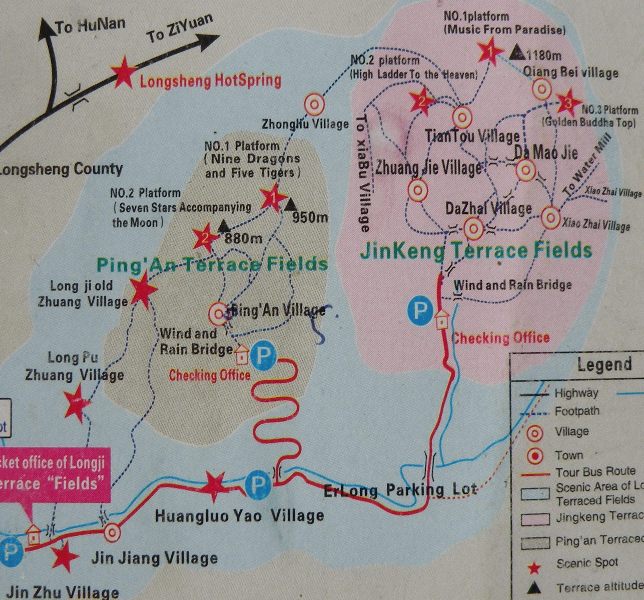
Yangshuo – globetrotters Mecca. Certainly it's worth to come here, because the limestone hills making a unique character. This place is commercialized and much of the attraction are not worth the money, but anyway Yangshuo surrounding area is charming.
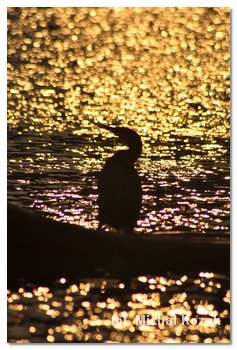 The first attraction which we have chosen was "Impression Liu Sanjie" light and sound show. This is performance on the water with 500-600 artists. Unfortunately tickets are very expensive - the best seats cost almost 700 Y, second class 350 Y, and the cheapest one 198 Y. These are the official prices, so you should bargain. We found an agency that let us see the spectacle from the opposite river bank, where villagers have organized themselves platforms and chairs. We had a little bit too far to see the show properly. Same with the music, we could hear it, but not loudly enough to feel the special atmosphere. Anyway, it was just 50 Y, but I wasn't impressed with choreography, I think it wasn't worth to see at all. There were some nice moments, but generally music combination with art performance wasn't good.
The first attraction which we have chosen was "Impression Liu Sanjie" light and sound show. This is performance on the water with 500-600 artists. Unfortunately tickets are very expensive - the best seats cost almost 700 Y, second class 350 Y, and the cheapest one 198 Y. These are the official prices, so you should bargain. We found an agency that let us see the spectacle from the opposite river bank, where villagers have organized themselves platforms and chairs. We had a little bit too far to see the show properly. Same with the music, we could hear it, but not loudly enough to feel the special atmosphere. Anyway, it was just 50 Y, but I wasn't impressed with choreography, I think it wasn't worth to see at all. There were some nice moments, but generally music combination with art performance wasn't good.
Cycling is a very popular activity around Yangshuo. Hiring bike for a full day costs between 10 Y and 20 Y. We prefer hiking than cycling, and anyway to get on the bike trail, you first need to ride on the smoggy road in dangerous traffic. So we arrived to Baisha village by bus, and thus we walked to the Dragon Bridge in 25 minutes. Hence, on both sides of the Yulong River you might heading toward south-east. The area is beautiful, perfect for peaceful walk. We chose the western side of the river and it was probably a better choice, because on the opposite side we have seen some 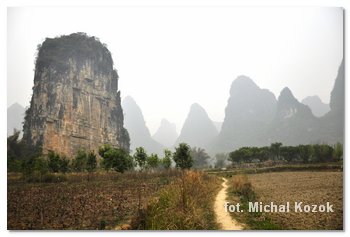 cars from time to time. On our side the path was almost not in use, and because we were without bikes, we could walk on small paths between the cultivated small fields. Thanks to that we were closer to the river, and away from brick-concrete villages. Only the weather was not good, there was a gray sky, same like in almost all China situated below 2000m altitude. Despite the lack of any bright colour of landscape, the limestone hills put us in admiration. Their wonderful shapes, magic atmosphere, peaceful mist etc. made an impression. Trekking from Dragon Bridge to Moon Hill took us 3.5 hours (14 km), with no many photo session on the way. Characteristic Moon Hill (Yueliang Shan) is a rock with a hole in the middle. Looks ok, but I didn't see the reason to pay 15 Y just to walk under the arch (over 1,200 stairs up).
cars from time to time. On our side the path was almost not in use, and because we were without bikes, we could walk on small paths between the cultivated small fields. Thanks to that we were closer to the river, and away from brick-concrete villages. Only the weather was not good, there was a gray sky, same like in almost all China situated below 2000m altitude. Despite the lack of any bright colour of landscape, the limestone hills put us in admiration. Their wonderful shapes, magic atmosphere, peaceful mist etc. made an impression. Trekking from Dragon Bridge to Moon Hill took us 3.5 hours (14 km), with no many photo session on the way. Characteristic Moon Hill (Yueliang Shan) is a rock with a hole in the middle. Looks ok, but I didn't see the reason to pay 15 Y just to walk under the arch (over 1,200 stairs up).
On Yulong River bamboo rafting is in offer. It can be done at various parts between the Dragon Bridge and the main paved road between Yangshuo and Moon Hill. The advantage of these rafts, compared to those on Li River (see below), is the fact that they are made from real bamboo (not plastic) and they do not have a motor engine – the owner is using a long bamboo stick. Here we sail only with current down the river, because on the way we have a few small concrete dams, not able to sail against the stream. The final offer we got, was 100 Y for two people for about 30-40 minutes cruise. It's hard to tell me which rafting is better - a real bamboo and silence on the Yulong River, or a loud motor and plastic raft, but more beautiful scenery on Li River (see below, in both cases you can take a bike on the raft).
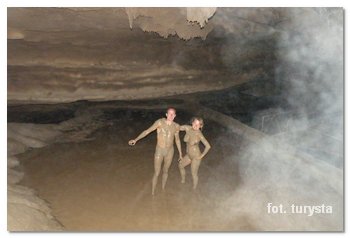 There is a "Water Cave" (Shui Yan) nearby Moon Hill . As the agencies advices, in the area are many fake caves, only that one is the real one (mean the closest to natural one). As they guarantee in that Water Cave there are not colorful lights, not carved artificial stalagmites etc. It turned out that a ticket bought through the agency was much cheaper than those offered on the spot - the official price at gate is 120 Y, and agencies in Yuangshuo selling it for 80 Y (we hardly bargained down to 60 Y). The ticket price includes minibus transport to the cave (2 x 5 km), boat ride inside the cave, guide and baths in three different places. The cave entry has very low clearance, but inside chambers might reach up to 50 meters height. I must admit that the cave has pretty interesting structures of stalactites, stalagmites and various rock formations, interestingly presented by the guide. After more than 20 minute walk into the cave we reached an underground swimming pool. However, the water temperature wasn't encouraging for swimming - I left the pool very quickly. Later on we went to the mud bath, where you can splash and put mud on yourself. From there we hurried up to the hot springs - 40°C temperature sounds much more pleasant. It was a pure pleasure, it was hard to went back. Two hours spending in the cave were even interesting, but at this moment I am already touchy on point of Chinese interference into the nature, for the reason of tourism commercialization. I wonder if these mud and hot springs are a natural attractions.
There is a "Water Cave" (Shui Yan) nearby Moon Hill . As the agencies advices, in the area are many fake caves, only that one is the real one (mean the closest to natural one). As they guarantee in that Water Cave there are not colorful lights, not carved artificial stalagmites etc. It turned out that a ticket bought through the agency was much cheaper than those offered on the spot - the official price at gate is 120 Y, and agencies in Yuangshuo selling it for 80 Y (we hardly bargained down to 60 Y). The ticket price includes minibus transport to the cave (2 x 5 km), boat ride inside the cave, guide and baths in three different places. The cave entry has very low clearance, but inside chambers might reach up to 50 meters height. I must admit that the cave has pretty interesting structures of stalactites, stalagmites and various rock formations, interestingly presented by the guide. After more than 20 minute walk into the cave we reached an underground swimming pool. However, the water temperature wasn't encouraging for swimming - I left the pool very quickly. Later on we went to the mud bath, where you can splash and put mud on yourself. From there we hurried up to the hot springs - 40°C temperature sounds much more pleasant. It was a pure pleasure, it was hard to went back. Two hours spending in the cave were even interesting, but at this moment I am already touchy on point of Chinese interference into the nature, for the reason of tourism commercialization. I wonder if these mud and hot springs are a natural attractions.
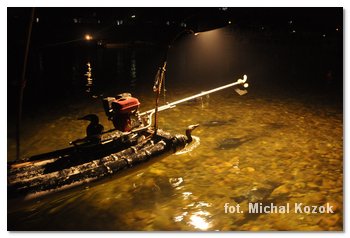 Once I have seen the BBC documentary film showing how trained cormorants catching fish. It looked incredibly beautiful. I am fascinated about authentic human cooperation with animals, training them for hunting. It turned out that this film was shot in this area. However, I expected that the performance will be show for tourist. After the sunset we embarked the raft (maximum of six people), started the engine and sailed out onto Li River, almost in the Yangshuo centre. We waited for an old fisherman on the other tiny motor raft with bright handing bulb. Looks like it was another tourist trap. Old man had six cormorants sitting on his boat, he used a bamboo stick to move faster. Now, however, he used the stick to kick off the birds to dive into the cold water. Finally cormorants started swim next to us and in front of fisherman raft, under the lamp. Moments later the "show" began and the birds started to dive in the clear shallow river. We saw the birds chasing a fish, catching them in their beak. But they could not swallow it because their throats were tightened by the string. Some more clever cormorants jumped onto our raft, where the fishermen couldn't rich them with his stick.
Once I have seen the BBC documentary film showing how trained cormorants catching fish. It looked incredibly beautiful. I am fascinated about authentic human cooperation with animals, training them for hunting. It turned out that this film was shot in this area. However, I expected that the performance will be show for tourist. After the sunset we embarked the raft (maximum of six people), started the engine and sailed out onto Li River, almost in the Yangshuo centre. We waited for an old fisherman on the other tiny motor raft with bright handing bulb. Looks like it was another tourist trap. Old man had six cormorants sitting on his boat, he used a bamboo stick to move faster. Now, however, he used the stick to kick off the birds to dive into the cold water. Finally cormorants started swim next to us and in front of fisherman raft, under the lamp. Moments later the "show" began and the birds started to dive in the clear shallow river. We saw the birds chasing a fish, catching them in their beak. But they could not swallow it because their throats were tightened by the string. Some more clever cormorants jumped onto our raft, where the fishermen couldn't rich them with his stick. 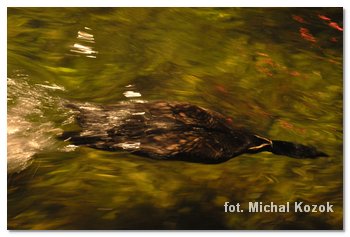 We were sailing next to the fisherman and enjoyed the diving cormorants show, it was beautiful. After about 20 minutes we came to the shore, and the fisherman caught cormorants and pulled out the fish from their esophagus. Unfortunately it was not a great hunt, just a few fish. At the end the string was removing from their neck and cormorants were given award in the form of fish, in order do not lose further motivation. Apparently in the heart of Yangshuo not many fish left, but this place is convenient for the agencies to bring the tourists here - walking distance cost less than using transport. Birds went ashore and spread the wings to dry them in the wind. Older man let us keep the bird on our shoulders. We said goodbye to the fisherman, and our skipper tried to take us for "Light and Sound" show, but we were there a day before. Then we were returning to the harbour, and on the way we saw again our fisherman, he was alone, without any tourists. He was continuing a fishing with cormorants. That was great for me, as it proved that it wasn't an artificial demonstration for tourists, but the real authentic hunting. For me this is important, because I was even thinking to skip this attraction, as I hate torturing animals. If, however, this fishing helps to collect food for fisherman family, then the whole thing have another dimension.
We were sailing next to the fisherman and enjoyed the diving cormorants show, it was beautiful. After about 20 minutes we came to the shore, and the fisherman caught cormorants and pulled out the fish from their esophagus. Unfortunately it was not a great hunt, just a few fish. At the end the string was removing from their neck and cormorants were given award in the form of fish, in order do not lose further motivation. Apparently in the heart of Yangshuo not many fish left, but this place is convenient for the agencies to bring the tourists here - walking distance cost less than using transport. Birds went ashore and spread the wings to dry them in the wind. Older man let us keep the bird on our shoulders. We said goodbye to the fisherman, and our skipper tried to take us for "Light and Sound" show, but we were there a day before. Then we were returning to the harbour, and on the way we saw again our fisherman, he was alone, without any tourists. He was continuing a fishing with cormorants. That was great for me, as it proved that it wasn't an artificial demonstration for tourists, but the real authentic hunting. For me this is important, because I was even thinking to skip this attraction, as I hate torturing animals. If, however, this fishing helps to collect food for fisherman family, then the whole thing have another dimension.
 The next day brought a weather improvement. The temperature was the same (over 20°C), the sky was still far from the blue, but the air transparency finally improved. We went to Yangdi village by bus, where we started our hike, south along Li River (rafting to Xianping available for minimum of 100 Y per 2 persons). The nearly 20 kilometers trail leads among idyllic scenery. Officially, the route requires three times the river crossing. When you got off from the bus you should cross the river (10 Y for two people after bargain), and after 40 minutes walking you are going back to the western bank again, from where the views are nicer. We have tried to support locals, so we were purchasing from elders delicious sweet oranges and eating in tiny roadside pubs. Locals usually before they said "good morning", they were saying "bamboo", offering the rafting. But when they understood that we are hiking, they smiled and greeted warmly.
The next day brought a weather improvement. The temperature was the same (over 20°C), the sky was still far from the blue, but the air transparency finally improved. We went to Yangdi village by bus, where we started our hike, south along Li River (rafting to Xianping available for minimum of 100 Y per 2 persons). The nearly 20 kilometers trail leads among idyllic scenery. Officially, the route requires three times the river crossing. When you got off from the bus you should cross the river (10 Y for two people after bargain), and after 40 minutes walking you are going back to the western bank again, from where the views are nicer. We have tried to support locals, so we were purchasing from elders delicious sweet oranges and eating in tiny roadside pubs. Locals usually before they said "good morning", they were saying "bamboo", offering the rafting. But when they understood that we are hiking, they smiled and greeted warmly.
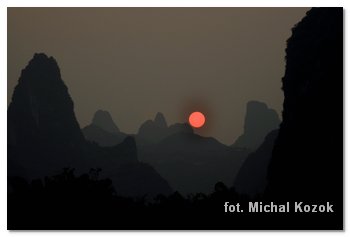 After nearly three hours hike we came to a third crossing - this time a car ferry operates there. We however, made a mistake and we continued a trek on the western side of the river. But there was a small problem – I couldn't see the trail, as vertical rock was falling straight into a river. It seemed, however, that there was the trail in forest above the rock. Well, for over an hour we struggled with bristling bush. The jungle of bamboo, stones, thorny plants etc. discourage us from hiking completely. When we finally crossed it, we found out there is no passage through the deep river. We had no choice, we tried raft hitchhike. The third one who
After nearly three hours hike we came to a third crossing - this time a car ferry operates there. We however, made a mistake and we continued a trek on the western side of the river. But there was a small problem – I couldn't see the trail, as vertical rock was falling straight into a river. It seemed, however, that there was the trail in forest above the rock. Well, for over an hour we struggled with bristling bush. The jungle of bamboo, stones, thorny plants etc. discourage us from hiking completely. When we finally crossed it, we found out there is no passage through the deep river. We had no choice, we tried raft hitchhike. The third one who  stopped, gave us a lift (20 Y for two persons) to Xianping village. And here I must admit that the sightseeing from the river perspective is great as well. It's fun to hike on the banks, but the river rafting is definitely worth trying. Next time I would walk one direction and raft in the return way, ending in the evening in Xianping (a better sunset view, and more evening buses returning to Yangshuo). An alternative could also be a large tourist boat runs between Guilin and Yangshuo.
stopped, gave us a lift (20 Y for two persons) to Xianping village. And here I must admit that the sightseeing from the river perspective is great as well. It's fun to hike on the banks, but the river rafting is definitely worth trying. Next time I would walk one direction and raft in the return way, ending in the evening in Xianping (a better sunset view, and more evening buses returning to Yangshuo). An alternative could also be a large tourist boat runs between Guilin and Yangshuo.
Struggling through the bushes hurts a little, but thanks to that we had a wonderful 15-minute rafting, which brought us to our destination place at perfect timing - a 20 yuan note lookout on sunset (east side of the river). Setting sun was perfect, the whole landscape was covered in yellow glow, irregular opposite black hills were contrasting to the shining landscape, and a fisherman stands on the boat with his cormorants was in the center of sun rays reflecting on the river. It was a photographic paradise. After the crazy session we went to the east, along the river to the Xianping village (15 minutes walk), where on the bridge (on the north-west side of town), we have seen huge red sun.
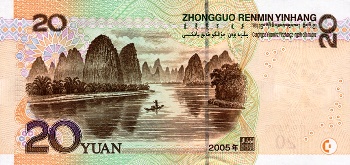
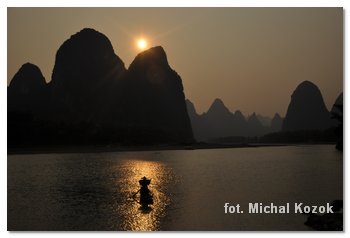
It was 15th day after the New Year began. The full moon was coming, what meant the end of the New Year carnival (Lantern Festival). The event took place in the town park, where hundreds of glowing lanterns were hanging. The Chinese crowded the park, what allowed us to felt the specific atmosphere. I like that parents were carrying their children on the shoulders, instead seating in the pub with colleagues.  There were performances, lotteries, games etc. The most popular, however, was free dumplings (tangyuan) consumption. Here you could enjoy them from the street restaurants. Before eating we could enjoy making these handmade dumplings on the large common tables. Generally speaking, that day we saw how locals were having fun. At the end of the event people gathered along the river for the fireworks show. True, we have seen many small fireworks for the last month, but these were organized by the city consul and were sensational. I guess it could be thanks to the fact that they were very close - just across the river, less than 200 meters away. Bangs, thunders and flashes accompanied us for over 20 minutes. A lot of older people came up this day and I watched their happy faces, while show was presented.
There were performances, lotteries, games etc. The most popular, however, was free dumplings (tangyuan) consumption. Here you could enjoy them from the street restaurants. Before eating we could enjoy making these handmade dumplings on the large common tables. Generally speaking, that day we saw how locals were having fun. At the end of the event people gathered along the river for the fireworks show. True, we have seen many small fireworks for the last month, but these were organized by the city consul and were sensational. I guess it could be thanks to the fact that they were very close - just across the river, less than 200 meters away. Bangs, thunders and flashes accompanied us for over 20 minutes. A lot of older people came up this day and I watched their happy faces, while show was presented.

Hunan
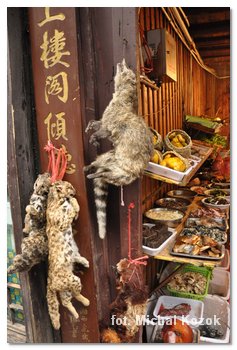 Fenghuang is a town which we knew from friend's photos. They described it as "old wooden town". Maybe if that would be our first attraction during this trip, we were satisfied. Anyway, after two months staying in our concrete village everything else would be beautiful. But now, when we already visited the Yunnan old towns, Fenghuang simply didn't seem to be impressive. First of all, we did not like the fact that it is not a wooden town, it's only made to look like it. In fact, there are brick and concrete houses covered with thin timbers. Chinese even didn't take an effort to hide it - all houses side walls were ugly. So, everything is done for tourists – the only front houses facades are covered by wood, making an impression that looks nice. One day before we walked in T-shirts and shorts (Yangshuo), and here again was so cold, that we had to wear all our clothes. There were no western tourists, so cooperation with locals look quite interesting. Also, low souvenir prices, no aggressive vendors caused that we were shopping around. A surprising thing was the unusual restaurants displays. First of all, they kept livestock in cages - quail, chicken, fish, frog, guinea pig etc. Next to them you could see their “family members” in form of skin peeled rabbits, pheasants, nutrias, but also all sorts of cats likely creation - in this case we were ordering only vegetarian dishes.
Fenghuang is a town which we knew from friend's photos. They described it as "old wooden town". Maybe if that would be our first attraction during this trip, we were satisfied. Anyway, after two months staying in our concrete village everything else would be beautiful. But now, when we already visited the Yunnan old towns, Fenghuang simply didn't seem to be impressive. First of all, we did not like the fact that it is not a wooden town, it's only made to look like it. In fact, there are brick and concrete houses covered with thin timbers. Chinese even didn't take an effort to hide it - all houses side walls were ugly. So, everything is done for tourists – the only front houses facades are covered by wood, making an impression that looks nice. One day before we walked in T-shirts and shorts (Yangshuo), and here again was so cold, that we had to wear all our clothes. There were no western tourists, so cooperation with locals look quite interesting. Also, low souvenir prices, no aggressive vendors caused that we were shopping around. A surprising thing was the unusual restaurants displays. First of all, they kept livestock in cages - quail, chicken, fish, frog, guinea pig etc. Next to them you could see their “family members” in form of skin peeled rabbits, pheasants, nutrias, but also all sorts of cats likely creation - in this case we were ordering only vegetarian dishes.

Henan
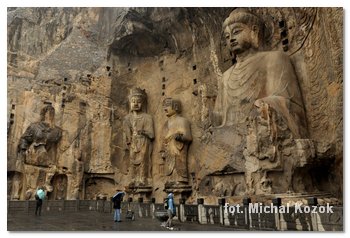 Four Chinese sights, where sculptures were carved in the rock, are world famous and protected by UNESCO. I have seen already those in Datong and Dazu, they made a great impression on me. I wanted see more sculptures, so this time I went to Louyang city. The place is called Longmen Shiku, which means Dragon Cave. It is a complex of hundreds of tiny caves carved in cliff on both sides of Yi River - they contain more than 100,000 statues and images of Buddha. And despite of terribly weather – raining and freezing wind - the place has left an unforgettable impression. The statues were not painted with any colour, many of them were destroyed or stolen, but anyway this complex is worth visiting. Why people here spent their entire lives on such a titanic work? Caves on the western side are much more developed and renovated, they are bigger, making this side crowded by tourist groups. However, on the eastern side you can't see as much, mainly because of smaller conservators work. But this allowed us to stay a little bit alone, see how a real old Buddha statues looks like. From here we have an interesting view on the western riverside, allowing to see how huge the caves complex is (around 1 kilometer long). Situated on the eastern bank a big Xiangshan Temple is also included in the ticket price, but in my opinion is not worth visiting (particularly new and it looks like there are no monks at all). Nearby there is also a grave of the local artist, but also there is not much to see, unless you are fan of Chinese park atmosphere.
Four Chinese sights, where sculptures were carved in the rock, are world famous and protected by UNESCO. I have seen already those in Datong and Dazu, they made a great impression on me. I wanted see more sculptures, so this time I went to Louyang city. The place is called Longmen Shiku, which means Dragon Cave. It is a complex of hundreds of tiny caves carved in cliff on both sides of Yi River - they contain more than 100,000 statues and images of Buddha. And despite of terribly weather – raining and freezing wind - the place has left an unforgettable impression. The statues were not painted with any colour, many of them were destroyed or stolen, but anyway this complex is worth visiting. Why people here spent their entire lives on such a titanic work? Caves on the western side are much more developed and renovated, they are bigger, making this side crowded by tourist groups. However, on the eastern side you can't see as much, mainly because of smaller conservators work. But this allowed us to stay a little bit alone, see how a real old Buddha statues looks like. From here we have an interesting view on the western riverside, allowing to see how huge the caves complex is (around 1 kilometer long). Situated on the eastern bank a big Xiangshan Temple is also included in the ticket price, but in my opinion is not worth visiting (particularly new and it looks like there are no monks at all). Nearby there is also a grave of the local artist, but also there is not much to see, unless you are fan of Chinese park atmosphere.
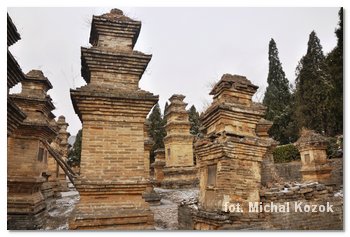 Legendary Shaolin Monastery, who hasn't heard of it? Which boy didn't try the oriental martial arts, didn't watch action movies with fighting monks? It is here in Henan Province, where Shaolin Monastery is located, the foundation of Kung Fu (here called Gongfu). In the fifth century one Indian monk called Damo (Bodhidharma), spent nine years meditating in a cave. He began to practice and imitate the animals movements - crane, monkey, mantis, leopard etc. With time the monks realized, that those animals movements allow themselves to defend, so monks began using them to self-defense. Unfortunately, the last century Cultural Revolution didn't miss the monastery and the temple was almost completely destroyed by the "Red Guards". The Temple was rebuilt in the late 70's, but it never returned to its previous glory. New concrete buildings have disappointed us. But we didn't come here to look at buildings, but tried to feel the atmosphere of this place. And it was partly succeed, thanks to dozens of martial arts schools which train here. Young boys in colorful kimonos are virtually everywhere, there are thousands of them. We have seen many schools located between the monastery and Dengfeng town. I admired boys which struggled the sessions despite the cold and snowing.
Legendary Shaolin Monastery, who hasn't heard of it? Which boy didn't try the oriental martial arts, didn't watch action movies with fighting monks? It is here in Henan Province, where Shaolin Monastery is located, the foundation of Kung Fu (here called Gongfu). In the fifth century one Indian monk called Damo (Bodhidharma), spent nine years meditating in a cave. He began to practice and imitate the animals movements - crane, monkey, mantis, leopard etc. With time the monks realized, that those animals movements allow themselves to defend, so monks began using them to self-defense. Unfortunately, the last century Cultural Revolution didn't miss the monastery and the temple was almost completely destroyed by the "Red Guards". The Temple was rebuilt in the late 70's, but it never returned to its previous glory. New concrete buildings have disappointed us. But we didn't come here to look at buildings, but tried to feel the atmosphere of this place. And it was partly succeed, thanks to dozens of martial arts schools which train here. Young boys in colorful kimonos are virtually everywhere, there are thousands of them. We have seen many schools located between the monastery and Dengfeng town. I admired boys which struggled the sessions despite the cold and snowing.
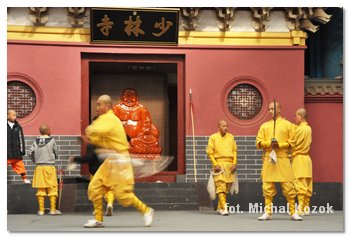 Early in the morning we went into the monastery. To the main temple is around 15 minutes walk (from the gate), and as I told before, there is nothing special inside. Five minutes behind it, there is curious Pagoda Forest. There are many small stone pagodas (up to 10 m in height). We returned close to the exit, as in ticket price, an half hour Kung Fu demonstration is included (the first one at 9:30 am, the last one at 5:30 pm, with three-hour lunch break in the afternoon). We watched young monks (or boys dressed as monks) warming up. It looked very interesting, we probably have seen all performers on the stage at time. Unfortunately, one lady came and announced that the first show is canceled - we couldn't wait for the next one, because we had the train tickets and had to rush to catch this train (in New Year's Festival it's a challenge to have a train ticket). They refunded us money!
Early in the morning we went into the monastery. To the main temple is around 15 minutes walk (from the gate), and as I told before, there is nothing special inside. Five minutes behind it, there is curious Pagoda Forest. There are many small stone pagodas (up to 10 m in height). We returned close to the exit, as in ticket price, an half hour Kung Fu demonstration is included (the first one at 9:30 am, the last one at 5:30 pm, with three-hour lunch break in the afternoon). We watched young monks (or boys dressed as monks) warming up. It looked very interesting, we probably have seen all performers on the stage at time. Unfortunately, one lady came and announced that the first show is canceled - we couldn't wait for the next one, because we had the train tickets and had to rush to catch this train (in New Year's Festival it's a challenge to have a train ticket). They refunded us money!
| town |
site |
price in Y |
€/per |
duration |
note |
comments |
| Wushan |
Three Little Gorges |
150 Y |
€15.0 |
4.5 h |
worth |
|
| Chongqing |
Chinese opera |
5 Y |
€0.5 |
30' |
ok |
spectacle takes longer |
| Dazu |
Baoding Shan |
stud. 45 Y |
€4.5 |
1.5 h |
worth |
normally 90 Y |
| Shengshousi Temple |
- |
- |
30' |
ok |
after 5pm no one asked for tickets |
| Czengdu |
Great Panda Breeding Center |
80 Y |
€8.0 |
4 h |
ok |
trip organized by hostel, included admission fee 58 Y |
| Leshan |
Grand Buddha Statue |
stud. 50 Y |
€5.0 |
1 h |
ok |
normally 90 Y |
| Emei Shan |
Entry fee |
stud. 80 Y |
€8.0 |
2 days |
ok |
normally 150 Y, validity 2 days |
| Litang |
Chode Gompa Monastery |
- |
- |
1 h |
ok |
|
| Xiangcheng |
Thangbzangdang Monastery |
15 Y |
€1.5 |
30' |
ok |
|
| Shangrila |
Sumtseling Monastery |
- |
- |
1 h |
poor |
normally 85 Y, student 55 Y |
| Tiger Leaping Gorge |
Entry fee |
- |
- |
2 days |
worth |
in summer 150 Y |
| descent to middle rapids |
10 Y |
€1.0 |
2.5 h |
worth |
better trail on Sky Ladder |
| Yulong Xueshan |
Yunshanping |
- |
- |
3 h |
worth |
officially cable car for 55 Y |
| Lijiang |
Dragon Pool Park |
- |
- |
1 h |
poor |
officially 80 Y, artificial park |
| Wanggu Lou Temple |
- |
- |
30' |
poor |
officially 15 Y |
| Dali |
Three Pagodas |
- |
- |
1 h |
ok |
officially 121 Y |
| Yuanyang |
Rice Terraces |
- |
- |
2 days |
super |
ticket office closed at foggy days |
| Langde |
Miao village |
- |
- |
1 day |
ok |
|
| near Longsheng |
Dragon's Backbone |
50 Y |
€5.0 |
2 days |
worth |
Chinese name - Longji |
| Yangshuo |
Imprerssion Liu Sanjie |
50 Y |
€5.0 |
1 h |
ok |
normally prices from 198 Y/ per |
| Water Cave |
60 Y |
€6.0 |
2 h |
ok |
swimming pool, mud bath, hot spring |
| cormorants fishing |
30 Y |
€3.0 |
30' |
worth |
|
hiking Dragon Bridge - Moon Hill |
- |
- |
3.5 h |
ok |
|
| hiking Yangdi - Xingping |
- |
- |
half day |
worth |
three raft river crossing |
| Fenghuang |
Old Town |
- |
- |
half day |
ok |
|
| Luoyang |
Longmen Caves |
120 Y |
€12.0 |
3 h |
worth |
no student discounts |
| Dengfeng |
Shaolin Monastery |
- |
- |
2 h |
ok |
normally 100 Y |
| |
|
|
€75 |
|
|
|

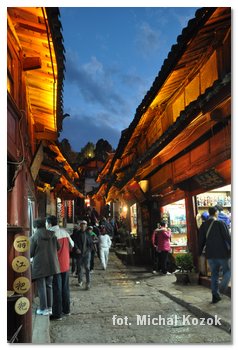 accommodation – in this trip during Chinese New Year I did not have any problem to find a cheap accommodation. In fact, sleeping bag and tent proved to be useless, as there weren't many “wild” places. There wasn't cold either, because most hotels are equipped with electric blankets. Sometimes happened that cheaper hotels didn't want to check-in us - then you should try in the next hostel, until succeeds.
accommodation – in this trip during Chinese New Year I did not have any problem to find a cheap accommodation. In fact, sleeping bag and tent proved to be useless, as there weren't many “wild” places. There wasn't cold either, because most hotels are equipped with electric blankets. Sometimes happened that cheaper hotels didn't want to check-in us - then you should try in the next hostel, until succeeds.
Sim's Cozy Garden Guesthouse in Chengdu is one of the best backpackers I have ever seen. First of all, there is everything you might need while travelling. In addition to the ideal living conditions there is a friendly atmosphere, you can see that the hosts care about your well-being, money are not the number one. The cheapest 8-bed dormitory costs 20 Y per bed, the room has a sink, bathroom with shower, toilet, heating (but not AC, this is in the room for 30 Y /bed), lockers, clean linen, curtains on the bed, drinkable water etc. The hostel has a garden, bar, restaurant with delicious food, internet (free wireless), DVD room, table tennis, games, books, tours and local attractions information. We arrived in Chengdu on the north train station and came to the hostel by foot (note: in Lonely Planet 2007 there is the old address near Wenshu Temple, now hostel is located 1.5 km north of previous location).
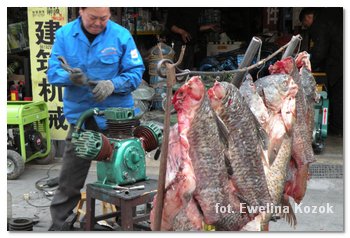 During the climbing Emei Shan we can sleep in number of huts or monasteries. Prices per night in dormitory room range from 20 to 100 Y (on the summit). We chose Elephant Bathing Pool Monastery (2,070 m) and to jump into our sleeping bags turned out to be unnecessary - beds were equipped with electric blankets. Meals are at fixed schedule - dinner at 6 pm, breakfast at 7:30 am. However I didn't like an unpleasant monastery staff. We didn't know that just behind the second monastery gate there is a privet hut leading by nice hosts - you can sleep there, eat at any time, they give you the bowl with warm water to refresh your feet.
During the climbing Emei Shan we can sleep in number of huts or monasteries. Prices per night in dormitory room range from 20 to 100 Y (on the summit). We chose Elephant Bathing Pool Monastery (2,070 m) and to jump into our sleeping bags turned out to be unnecessary - beds were equipped with electric blankets. Meals are at fixed schedule - dinner at 6 pm, breakfast at 7:30 am. However I didn't like an unpleasant monastery staff. We didn't know that just behind the second monastery gate there is a privet hut leading by nice hosts - you can sleep there, eat at any time, they give you the bowl with warm water to refresh your feet.
 In Baoguo village Teddy Bear hostel is just around the corner from the bus station. This is a real backpackers, although without Chengdu Sim's Cozy GH atmosphere. However, it's clean, with tasty food, free: wireless internet, luggage storage, rental a bamboo stick and crampons (in winter). Prices for dormitories are not listed on the reception, but they cost 30 or 35 Y. The room has 4 beds, air conditioning and bathroom. At the request I got a towel. The owner informs on the brochure about free transfer from the train station in Emei Shan - call Andy on 13890681961 or 0833-5590135.
In Baoguo village Teddy Bear hostel is just around the corner from the bus station. This is a real backpackers, although without Chengdu Sim's Cozy GH atmosphere. However, it's clean, with tasty food, free: wireless internet, luggage storage, rental a bamboo stick and crampons (in winter). Prices for dormitories are not listed on the reception, but they cost 30 or 35 Y. The room has 4 beds, air conditioning and bathroom. At the request I got a towel. The owner informs on the brochure about free transfer from the train station in Emei Shan - call Andy on 13890681961 or 0833-5590135.
In Kangding we slept near the bus station because the next day our bus was leaving at 6:30 am. But while walking around the town we visited, described by Lonely Planet, Black Tent Guesthouse. The atmosphere of this stylish wooden hostel looked fantastic, and costs only 20 Y per person. We regretted a little bit, but it was too far from the station. LP maps showed just 1 km distance, but in practice it was 3 times more. If you wish to find it, walk for 30 minutes from the station in the center direction, and on the right side of the river you'll see Anjue Monastery, and right next to it the guesthouse.
 Bamu Tibetian Guest House in Xiangcheng is a pure traditional Tibetan house. It is stylish, typical for the region, and very impressive inside. Nice family lives there. From the main bus station gate turn left and after 50 meters turn left uphill in the first street. The third building on the left side is decorated with a green door - the gateway to the Tibetan fort. The toilets are outside, no shower.
Bamu Tibetian Guest House in Xiangcheng is a pure traditional Tibetan house. It is stylish, typical for the region, and very impressive inside. Nice family lives there. From the main bus station gate turn left and after 50 meters turn left uphill in the first street. The third building on the left side is decorated with a green door - the gateway to the Tibetan fort. The toilets are outside, no shower.
In Shangrila, Litang and Dali there are a lot hostels, most are cheap - we had no booking, even during the Chinese New Year. We managed to bargain for a lower price (eg 30 Y per person in the double room) than other tourists got while booking in advance (eg 40 Y for a bed in dormitory room.)
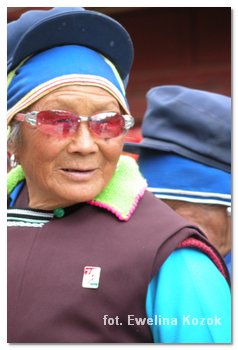 The budget option in Kunming is The Hump Hostel. A typical backpackers with information, restaurant and bar, wireless internet, luggage storage (3 Y /day) and plenty of space. Unfortunately, it is so popular that there was no vacancies in the dormitory (30 Y). However, they didn't kick us out, but proposed the DVD room with mattresses on the floor. We had to only wait until the bar got quiet (2 am), and in the morning they woke us up already at 8 am, because other tourists were ordering breakfast. For us it was not a problem. You can get to the hostel from the train station if you catch bus number 3, or you can walk there in less than half an hour.
The budget option in Kunming is The Hump Hostel. A typical backpackers with information, restaurant and bar, wireless internet, luggage storage (3 Y /day) and plenty of space. Unfortunately, it is so popular that there was no vacancies in the dormitory (30 Y). However, they didn't kick us out, but proposed the DVD room with mattresses on the floor. We had to only wait until the bar got quiet (2 am), and in the morning they woke us up already at 8 am, because other tourists were ordering breakfast. For us it was not a problem. You can get to the hostel from the train station if you catch bus number 3, or you can walk there in less than half an hour.
In Yuanyang region the tourism is already highly developed - most of the backpackers booked the accommodation in advance, paying a minimum of 60 Y in dormitory or 100 Y per person in double room. We walked from Yuanyang town to Sheng Cun village (between Bada and Duoyishu) where lady from the shop has provided us the room for 50 Y (we were there after 10 pm). However, in Duoyishu the weather was so bad that we resigned from further trekking and we checked-in to the hotel near the rice terraces – bargained the price for double room down to 60 Y. This was the hotel with the best view I had in my life - as soon as fog faded I run out with the camera on the hotel veranda. It was worth to stay here.
 In Kaili many hotels didn't want to accept us, it wasn't probably due to lack of vacant rooms, but the ban on receiving foreigners. Kaili is interesting at night, but I would prefer to sleep in nearby Miao villages, where there are a few tourist hostels. The next night we spent in Congjiang – awful town with not the nicest people.
In Kaili many hotels didn't want to accept us, it wasn't probably due to lack of vacant rooms, but the ban on receiving foreigners. Kaili is interesting at night, but I would prefer to sleep in nearby Miao villages, where there are a few tourist hostels. The next night we spent in Congjiang – awful town with not the nicest people.
In Yuangshuo the hotel choice is enormous, and on the main street (West Street) you can find cheap and great deals without any problems. Our room was almost perfect, and despite the New Year period, after bargain the price has dropped from 80 to 60 Y. The owners are selling the trips, so they can make an extra income from you anyway. However, the further away from West Street, the prices drop even more, both with hotels and tours.
In Zhengzhou no cheap hotel wanted to accept us (2 am). We had no choice like pitch a tent in the city center – no one hassled us. To Linyi city we arrived about 3 am, and this time we could not stay in the bus until morning. So, we pitched the tent next to the bus station.
| town |
hotel and address |
N |
accommodation |
price per night |
€/ per |
note |
comments |
| Yichang |
opposite the harbour in city centre |
1 |
double room |
60 Y/ room |
€3.0 |
7 |
WC, AC |
| Wushan |
one of many in the center |
2 |
double room |
40 Y/ room |
€2.0 |
6 |
|
| Dazu |
Hong Du Hotel, near the station |
1 |
double room |
50 Y/ room |
€2.5 |
6 |
WC, cold water |
| Czengdu |
Sim's Cozy Garden Hostel, LP, No 211, North Section 4, First Ring Rd |
1 |
dormitory |
20 Y/ per |
€2.0 |
10 |
real
backpackers |
| Leshan |
one of many in the centre |
1 |
double room |
40 Y/ room |
€2.0 |
5 |
WC, electric blanket |
| Emei Shan |
Elephant Bathing Pool Monastery |
1 |
dormitory |
30 Y/ per |
€3.0 |
5 |
electric blanket |
| Baoguo |
Teddy Bear Hotel, near the station |
1 |
dormitory |
30 Y/ per |
€3.0 |
8 |
WC, AC, wifi |
| Kangding |
one of many next to station |
1 |
double room |
40 Y/ room |
€2.0 |
6 |
electric blanket |
| Litang |
one of many next to station |
1 |
double room |
30 Y/ room |
€1.5 |
5 |
cold water, electric blanket |
| Xiangcheng |
Bamu Tibetian Guesthouse, LP, near the station |
1 |
dormitory |
20 Y/ per |
€2.0 |
7 |
|
| Shangrila |
Moon Guesthouse, 25 Beimeijie, Jiantanglu Xiang, ph.887 8225826 |
1 |
double room |
50 Y/ room |
€2.5 |
8 |
WC |
| Tiger Leaping Gorge |
Halfway Guest House |
1 |
dormitory |
20 Y/ per |
€2.0 |
8 |
|
| Lijiang |
Naxi Guest House, next to YHC |
2 |
double room |
60 Y/ room |
€3.0 |
6 |
WC, wifi |
| Kunming |
The Hump, LP, Jinmabiji Squere |
2 |
DVD room |
20 Y/ per |
€2.0 |
8 |
backpackers |
| Sheng Cun |
private house |
1 |
room |
50 Y/ room |
€2.5 |
4 |
no water, no WC |
| Duoyishu |
first house on the left before the welcoming gate |
1 |
double room |
60 Y/ room |
€3.0 |
6 |
veranda with fantastoc view |
| Kaili |
one of many in the centre |
1 |
double room |
40 Y/ room |
€2.0 |
4 |
cold water, electric blanket |
| Congjiang |
one of many in the centre |
1 |
double room |
50 Y/ room |
€2.5 |
7 |
wifi, WC |
| Heping |
one of many next to main road |
1 |
double room |
40 Y/ room |
€2.0 |
4 |
WC |
| Dragon's Terraces |
one of many in Tian Tou |
1 |
double room |
50 Y/ room |
€2.5 |
7 |
WC, super view |
| Yangshuo |
Bamboo House Inn, LP, West St |
2 |
double room |
60 Y/ room |
€3.0 |
8 |
WC, AC, wifi, balcony |
| Fenghuang |
YHA, LP |
1 |
dormitory |
25 Y/ per |
€2.5 |
6 |
cold |
| Shaolin Monastery |
one of many next to the parking |
1 |
double room |
50 Y/ room |
€2.5 |
4 |
cold, no hot water |
| |
in wild |
1.5 |
tent |
|
|
|
|
| |
in transport |
4.5 |
bus, train |
|
|
|
|
| |
hospitality |
1 |
|
|
|
|
|
| |
couchsurfing |
7 |
|
|
|
|
|
| |
|
41 |
|
|
€65(27) |
|
|

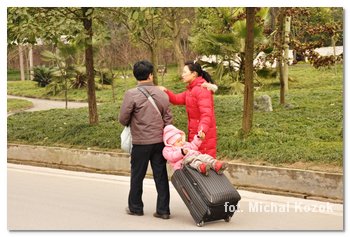 transport – generally speaking – buses are faster, but three times more expensive than trains. Unfortunately, during the Chinese New Year and other major holidays we are often not able to buy train tickets – they are sold out.
transport – generally speaking – buses are faster, but three times more expensive than trains. Unfortunately, during the Chinese New Year and other major holidays we are often not able to buy train tickets – they are sold out.
There are five classes on the slow ferry on Yangtze River - we were in the fourth class and wondered that the cabin contained only 4 beds - clean linen, TV, window. The only negative issue was the smell of cigarettes. The most important thing - on the slow ferry you can go outside on the deck and see the views - which cannot be done on the express boat, as you are closed inside, watching the views through the plastic window. From Yichang both ferries run only to Wanzhou, where you have to change (for the next boat or for the 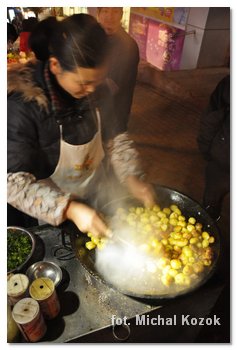 bus).
bus).
Get to Baoding Shan in Dazu you can do by minibus – but they don't depart from the front of bus station (as reported in LP), but you must go there on foot (20 min) or by minibus no. 4. The conductor give you a tourists price of 5 Y, but locals pay 3 Y per person. The last bus from Dazu to Chongqing leaves at 6 pm, and to Chengdu they run only in the morning.
From the north railway station in Chengdu you can reach Sim's Cozy Garden Guesthouse by bus no. 28 (get off close to the BeiMen bus station). To the city center and Wenshu temple we can go by bus no. 55. From the city center to Wu Hou Temple catch bus no. 1
After leaving Emei Shan bus station catch a bus going to the right direction. Get off at the roundabout with the horse statue, cross it on the other side and take bus no. 5, going to Baoguo. From Baoguo there are plenty of buses going to different trekking starting points - the expensive one way ride cost 20 Y to Wuxiangang or Wannian, and 40 Y close to the peak (Leidongping parking lot). You can reach Baoguo directly from bus stations in Leshan and Chengdu.
 Between Mpression Jaku, Yunshanping and Baishui run free green buses. But to get to the Yak Meadow or Lijiang you have to hire a car by yourself. To Lijiang in theory runs a minibus no. 7, but the driver wanted from us 200 Y, so we went hitchhike.
Between Mpression Jaku, Yunshanping and Baishui run free green buses. But to get to the Yak Meadow or Lijiang you have to hire a car by yourself. To Lijiang in theory runs a minibus no. 7, but the driver wanted from us 200 Y, so we went hitchhike.
From Litang to Xiangcheng there was no bus service. I do not know if it's a rule, or it just happened due to public holiday. In Chinese New Year, first week in May and in October some routes are suspended or the ticket price raised. Drivers also need to celebrate like everyone does. However, there was no problem to find an alternative minibus in front of the bus terminal – it's departing when full of passengers. How it happens in western Sichuan, buses leave early in the morning - between 6 and 7 am. The route to Xiangcheng wasn't paved between the last Sichuan village, and the first one in Yunnan. It was a beautiful ride with excellent scenery.
From Dali to Kunming there is a railway. You can take a night train, but only sleeper tickets are available - 108 Y. There is also a daily train (12:50 pm) and you can purchase a ticket (31 Y), but without a seat number - first come, first seated. Alternatively there are express buses which go twice faster than train (only 5 hours), but they cost nearly 100 Y.
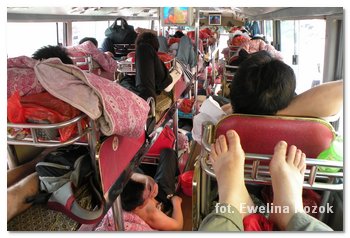 If you want to get south from Kunming - from the railway station catch a bus number 154, which runs to the new south bus terminal. To Yuanyang there is a bus departing at 10:20 am and two buses in the evenings (the last one at 8 pm). We took a morning bus - it turned out that the bus which runs during the day is sleeper-bus (128 Y). Few days later when we wanted return to Kunming, it turned out that due to the end of Chinese New Year the fares increased up, an average of 50%. The ride to Kunming was for 166 Y (9 am, 4 and 6:30 pm). Alternatively you can go to Gejiu for 24 Y (standard fare), and from there are a lot of buses to the province capital (81 Y). We got a minibus, which driver had collected 5 Y extra per passenger to go faster through highway toll's.
If you want to get south from Kunming - from the railway station catch a bus number 154, which runs to the new south bus terminal. To Yuanyang there is a bus departing at 10:20 am and two buses in the evenings (the last one at 8 pm). We took a morning bus - it turned out that the bus which runs during the day is sleeper-bus (128 Y). Few days later when we wanted return to Kunming, it turned out that due to the end of Chinese New Year the fares increased up, an average of 50%. The ride to Kunming was for 166 Y (9 am, 4 and 6:30 pm). Alternatively you can go to Gejiu for 24 Y (standard fare), and from there are a lot of buses to the province capital (81 Y). We got a minibus, which driver had collected 5 Y extra per passenger to go faster through highway toll's.
From Kaili town to Langde village you should take a bus from the long-distance terminal. Do not trust the Lonely Planet map, since the village Langde is not north-west from Kaili, but south-east, 1 km side from the main road, 16 km before Leishan town.
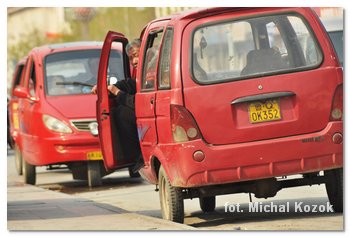 Going to Dragon's Backbone Rice Terraces, beware the trap in the form of two villages called Heping. If you want to get to the terraces directly, go to Ping'an or Huangluo village, but if you are planning trekking, then you will be interested in Heping village, just 20 km south of Longsheng, on the way to Guilin. Unfortunately, the bus ride fare for “white faces” often increases on the occasion. They demanded four times higher fee from us – we walked two hours until the next driver took us for the normal price.
Going to Dragon's Backbone Rice Terraces, beware the trap in the form of two villages called Heping. If you want to get to the terraces directly, go to Ping'an or Huangluo village, but if you are planning trekking, then you will be interested in Heping village, just 20 km south of Longsheng, on the way to Guilin. Unfortunately, the bus ride fare for “white faces” often increases on the occasion. They demanded four times higher fee from us – we walked two hours until the next driver took us for the normal price.
In Yangshuo there isn't a transport mafia, so travelling to surrounding villages is stress free. Only travel to Guilin was a little frustrated - the official express bus ticket purchased at the bus station costs 15 Y, but private slower buses started with 18 Y – we hardly bit the price down to 25 Y for two of us (it is not about money, but the honesty).
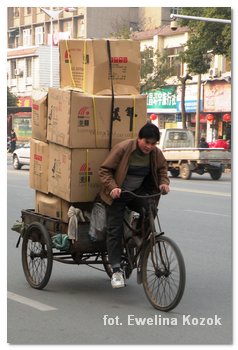 Travelling during Chinese New Year few times took its toll. The first time we had a problem to buy a cheap ticket at departure day, from Jinan to Zhengzhou (we went by expensive express train). The next problem occurred before the end of Spring Festival - coming from Kunming to Yuanyang, where there weren't space in direct buses (all sold out). This, however, were not real problems, as eventually we arrived where we planned to. The worst time was after the New Year just had finished, it was hard to get any train ticket, but fortunately again, buses network saved us – much more expensive, but still tickets available. For trains a lot depends from the officer on other side of the ticket office – if she/he is clever, will help you to find some combinations of trains to put you finally to your destination. Unfortunately most of them preferred just to say “No”, what means they are lazy to check other possibilities for you.
Travelling during Chinese New Year few times took its toll. The first time we had a problem to buy a cheap ticket at departure day, from Jinan to Zhengzhou (we went by expensive express train). The next problem occurred before the end of Spring Festival - coming from Kunming to Yuanyang, where there weren't space in direct buses (all sold out). This, however, were not real problems, as eventually we arrived where we planned to. The worst time was after the New Year just had finished, it was hard to get any train ticket, but fortunately again, buses network saved us – much more expensive, but still tickets available. For trains a lot depends from the officer on other side of the ticket office – if she/he is clever, will help you to find some combinations of trains to put you finally to your destination. Unfortunately most of them preferred just to say “No”, what means they are lazy to check other possibilities for you.
In Zhengzhou we experienced a new situation. We already had standing tickets for the train - we bought it two days earlier. However, they didn't let people get on the train. 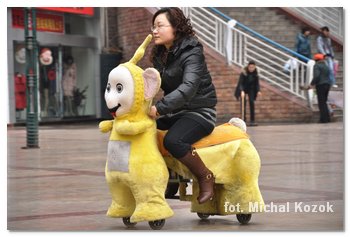 We were thrown out from the train station (a few hundred people) in total confusion. Eventually we managed to go for cash refund. Anyway, I do not understand how you can have an electronic reservation system and suddenly, at train arrival, say that the train is too crowded - they should know how many seats and standing places they sold (standing place has always designated number of carriage). Fortunately, the opposite long-distance bus terminal have sold us the tickets for the evening departure - it was much more expensive, but much faster as well. It is a pity that someone has planned a trip that you arriving at 3 am. They could plan it a little later or earlier.
We were thrown out from the train station (a few hundred people) in total confusion. Eventually we managed to go for cash refund. Anyway, I do not understand how you can have an electronic reservation system and suddenly, at train arrival, say that the train is too crowded - they should know how many seats and standing places they sold (standing place has always designated number of carriage). Fortunately, the opposite long-distance bus terminal have sold us the tickets for the evening departure - it was much more expensive, but much faster as well. It is a pity that someone has planned a trip that you arriving at 3 am. They could plan it a little later or earlier.
| day |
destination |
transport |
price in Y |
€/ per |
duration |
km |
| 1 |
Yishui - Jinan (Shandong Province) |
bus |
77 Y |
€7.7 |
4 h |
220 |
| 1 |
Jinan - Zhengzhou (Henan Province) |
express train, hard seat |
207 Y |
€20.7 |
5 h |
670 |
| 2 |
Zhengzhou - Yichang (Hubei Province) |
night train, standing |
103 Y |
€10.3 |
10 h |
740 |
| 3 |
Yichang - Wushan (Chongquing Province) |
slow ferry, IV class |
108 Y |
€10.8 |
7.5 h |
167 |
| 4 |
Wushan - Three Little Gorges + return |
ferry and boat |
data in highlights |
4.5 h |
70 |
| 5 |
Wushan - Wanzhou |
express ferry |
175 Y |
€17.5 |
3.5 h |
154 |
| 5 |
Wanzhou - Chongquing City |
bus |
110 Y |
€11.0 |
3.5 h |
300 |
| 8 |
Chongquing City - Dazu |
bus |
53 Y |
€5.3 |
2.5 h |
120 |
| 8 |
Dazu - Baoding Shan + return |
2x minibus |
2x 3Y |
€0.6 |
2x 20' |
2x 13 |
| 9 |
Dazu - Czengdu (Sichuan Province) |
bus |
81 Y |
€8.1 |
4.5 h |
310 |
| 10 |
Czengdu - Pandas + return |
minibus |
data in highlights |
2x 30' |
2x 10 |
| 10 |
Czengdu - Leshan |
bus |
44 Y |
€4.4 |
2 h |
140 |
| 11 |
Leshan - Emei Shan |
bus |
8 Y |
€0.8 |
40' |
30 |
| 11 |
Emei Shan City - Baoguo |
bus no 5 |
1.5 Y |
€0.2 |
10' |
7 |
| 11+12 |
Baoguo - Wuxiangang + return |
bus |
2x 20 Y |
€4.0 |
2x 15' |
2x 10 |
| 13 |
Baoguo - Emei Shan City |
taxi |
14 Y/ 2per |
€0.7 |
10' |
7 |
| 13 |
Emei Shan City - Yaan |
bus |
48 Y |
€4.8 |
3.5 h |
120 |
| 13 |
Yaan - Kangding |
bus |
71 Y |
€7.1 |
4.5 h |
180 |
| 14 |
Kangding - Litang |
bus |
84 Y |
€8.3 |
8 h |
285 |
| 15 |
Litang - Xiangcheng |
minibus |
90 Y |
€9.0 |
4 h |
205 |
| 16 |
Xiangcheng -Shangrila (Yunnan Province) |
bus |
87 Y |
€8.7 |
7.5 h |
200 |
| 17 |
Shangrila (Zhongdian) - Qiaotou |
bus |
30 Y |
€3.0 |
1.5 h |
100 |
| 17-18 |
Qiaotou - Daju |
walk |
- |
- |
2 days |
33 |
| 18 |
crossineg Yangtze |
boat (new ferry) |
20 Y |
€2.0 |
5' |
- |
| 18 |
Daju - Yunshanping |
bus with toursits |
25 Y |
€2.5 |
1.5 h |
35 |
| 19 |
Yunshanping - Mpression Jaku |
tourist bus |
- |
- |
15' |
15 |
| 19 |
Mpression Jaku - Lijiang |
hitchhike |
10 Y/ per |
€1.0 |
30' |
25 |
| 21 |
Lijiang - Dali (Old Town) |
bus |
40 Y |
€4.0 |
3 h |
165 |
| 23 |
Dali - Xiaguan (New Dali) |
bus no 8 |
1.5 Y |
€0.2 |
45' |
17 |
| 23 |
Xiaguan (New Dali) - Kunming |
train, standing |
31 Y |
€3.1 |
8 h |
380 |
| 24 |
Kunming - Yuanyang |
sleeper bus |
128 Y |
€12.8 |
7 h |
332 |
| 24-25 |
Yuanyang - Duoyishu |
walk + 2x hitchhiking |
5 Y |
€0.5 |
2 days |
24 |
| 26 |
Duoyishu - Bada |
walk |
- |
- |
1.5 h |
7 |
| 26 |
Bada - Yuanyang |
minibus |
10 Y |
€1.0 |
30' |
17 |
| 26 |
Yuanyang - Gejiu |
bus |
37 Y |
€3.7 |
2 h |
80 |
| 26 |
Gejiu - Kunming |
minibus |
100 Y |
€10.0 |
3.5 h |
285 |
| 27-28 |
Kunming - Kaili (Guizhou Province) |
train, hard seat |
55 Y |
€5.5 |
15.5 h |
900 |
| 28 |
Kaili - Langde + return |
bus + shared taxi |
9 + 10 Y |
€1.9 |
1h + 30' |
2x 28 |
| 29 |
Kaili - Congjiang |
bus |
87 Y |
€8.7 |
7 h |
250 |
| 30 |
Congjiang - Sanjiang (Guangxi Province) |
bus |
40 Y |
€4.0 |
3.5 h |
106 |
| 30 |
Sanjiang - Longsheng |
bus |
18 Y |
€1.8 |
1.5 h |
66 |
| 30 |
Longsheng - Heping |
bus |
3 Y |
€0.3 |
25' |
13 |
| 31-32 |
Heping - Dragon terraces - Da Zhai |
walk |
- |
- |
1.5 day |
34 |
| 32 |
Da Zhai - Heping |
walk + bus |
3.5 Y |
€0.4 |
2h + 30' |
24 |
| 32 |
Heping - Guilin |
bus |
25 Y |
€2.5 |
2 h |
73 |
| 32 |
Guilin - Yangshuo |
express bus |
15 Y |
€1.5 |
1.5 h |
65 |
| 34 |
Yangshuo - Baisha |
bus |
3 Y |
€0.3 |
15' |
9 |
| 34 |
Baisha - Dragon Bridge - Moon Hill |
walk |
- |
- |
3.5 h |
14 |
| 34 |
Moon Hiill - Water Cave + return |
minibus |
data in highlights |
2x 15' |
2x 5 |
| 34 |
Moon Hill - Yangshuo |
minibus |
3 Y |
€0.3 |
15' |
6 |
| 35 |
Yangshuo - Yangdi |
bus |
9.5 Y |
€1.0 |
1 h |
38 |
| 35 |
Yangdi - Xingping |
walk + boats |
10 Y |
€1.0 |
3.5h + 15' |
12 + 4 |
| 35 |
Xingping - Yangshuo |
bus |
7 Y |
€0.7 |
40' |
25 |
| 36 |
Yangshuo - Guilin |
bus |
12.5 Y |
€1.3 |
2 h |
65 |
| 36-37 |
Guilin - Huaihua (Hunan Province) |
sleeper bus |
130 Y |
€13.0 |
11 h |
380 |
| 37+38 |
Huaihua - Fenghuang + return |
2x bus |
2x 41 Y |
€8.2 |
2x 3 h |
2x 90 |
| 38-39 |
Huaihua - Wuchang (Hubei Province) |
express train, hard seat |
113 Y |
€11.3 |
13 h |
860 |
| 39 |
Wuchang - Zhengzhou (Henan Province) |
train, standing |
67 Y |
€6.7 |
8 h |
550 |
| 40 |
Zhengzhou - Luoyang |
express train, hard seat |
18 Y |
€1.8 |
3 h |
135 |
| 40 |
Luoyang - Longman Caves + return |
2x bus no 81 |
2x 1.5 Y |
€0.3 |
2x 50' |
2x 16 |
| 40 |
Luoyang - Shaolin Monastery |
bus |
17 Y |
€1.7 |
1.5 h |
68 |
| 41 |
Shaolin Monastery - Dengfeng |
bus no 8 |
2 Y |
€0.2 |
15' |
9 |
| 41 |
Dengfeng - Zhengzhou |
bus |
25 Y |
€2.5 |
1 h 45' |
80 |
| 41-42 |
Zhengzhou - Linyi (Shandong Province) |
night bus |
150 Y |
€15.0 |
6.5 h |
510 |
| 42 |
Linyi - Yishui |
bus |
22 Y |
€2.2 |
3 h |
90 |
| |
City transport |
bus, taxi |
70 Y |
€7.0 |
- |
- |
| |
|
|
|
€285 |
|
10170 |

Cost calculation
The total expenses of this 6-week journey were 620 €. The cost of living (for food, accommodation and transport) was 520 € in 41 days, what means less than 13 € daily. Additionally visiting the tourist attractions (mainly admission fees) cost me 75 €, and the other expenses 25 €.
 The food expenses were 173 € in 41 days = 4 € per day
The food expenses were 173 € in 41 days = 4 € per day
The transport expenses were 282 €, what means 7 € per day. The train, “hard seat” ticket cost average 1.0 € for 100 km, but bus ticket for the same distance was 3.4 €. We travelled in 9 provinces in 41 days, through a total of 10,170 km. = we covered average daily distance of 248 km. On trekking (city walks are not included) we walked a total of 190 km.
The accommodation expenses were 65 € - if I include the only paid accommodation, it would be the average cost of 2.4 € per night. The cheapest hostels costs between 3 and 6 € per double room. I spent in total 27 nights in hostels, 1.5 time I was sleeping in a tent in the wild, 4.5 nights in transport (one night half in the bus, and half in a tent), 8 nights we were invited for free hospitality (mainly couchsurfing).
back to top

![]()






![]()








 The next morning we went in Litang direction. When I have woken up by the morning sun rays, the bus was already at altitude around 4,000 meters above sea level. Landscape have been becoming more and more wild and interesting, the passing villages were very different from which we already knew from Chinese realities. When we descended from the pass into the Jalunga River ravine, we could say that we are in the Tibetan world. There were began appearing the big houses, like stone castles with leaning walls (like in cone). They weren't also in typical rectangular shapes, but irregular, with some notches, terraces on the upper floor, separate wings etc. Quite high, usually three floors one, and in the ground floor there were no windows at all. This was the most beautiful houses I have seen during this trip. Finally we reached the Yajiang village, which lies on the river cliff - many houses are still wooden, it made an impression. But we climbed higher, finally reaching the valley with Litang town.
The next morning we went in Litang direction. When I have woken up by the morning sun rays, the bus was already at altitude around 4,000 meters above sea level. Landscape have been becoming more and more wild and interesting, the passing villages were very different from which we already knew from Chinese realities. When we descended from the pass into the Jalunga River ravine, we could say that we are in the Tibetan world. There were began appearing the big houses, like stone castles with leaning walls (like in cone). They weren't also in typical rectangular shapes, but irregular, with some notches, terraces on the upper floor, separate wings etc. Quite high, usually three floors one, and in the ground floor there were no windows at all. This was the most beautiful houses I have seen during this trip. Finally we reached the Yajiang village, which lies on the river cliff - many houses are still wooden, it made an impression. But we climbed higher, finally reaching the valley with Litang town.



![]()


















![]()


![]()















![]()

![]()



![]()






![]()







![]()


